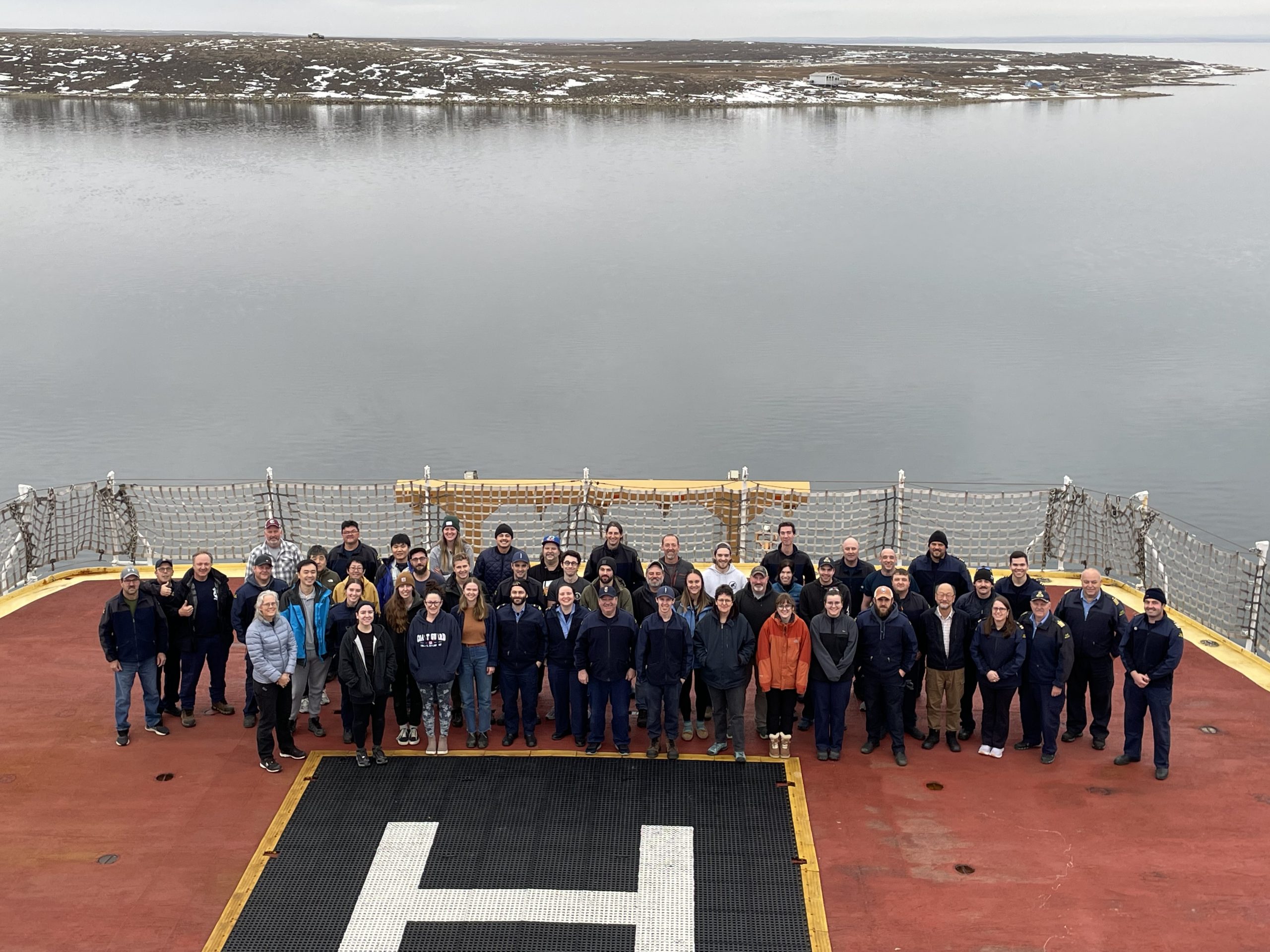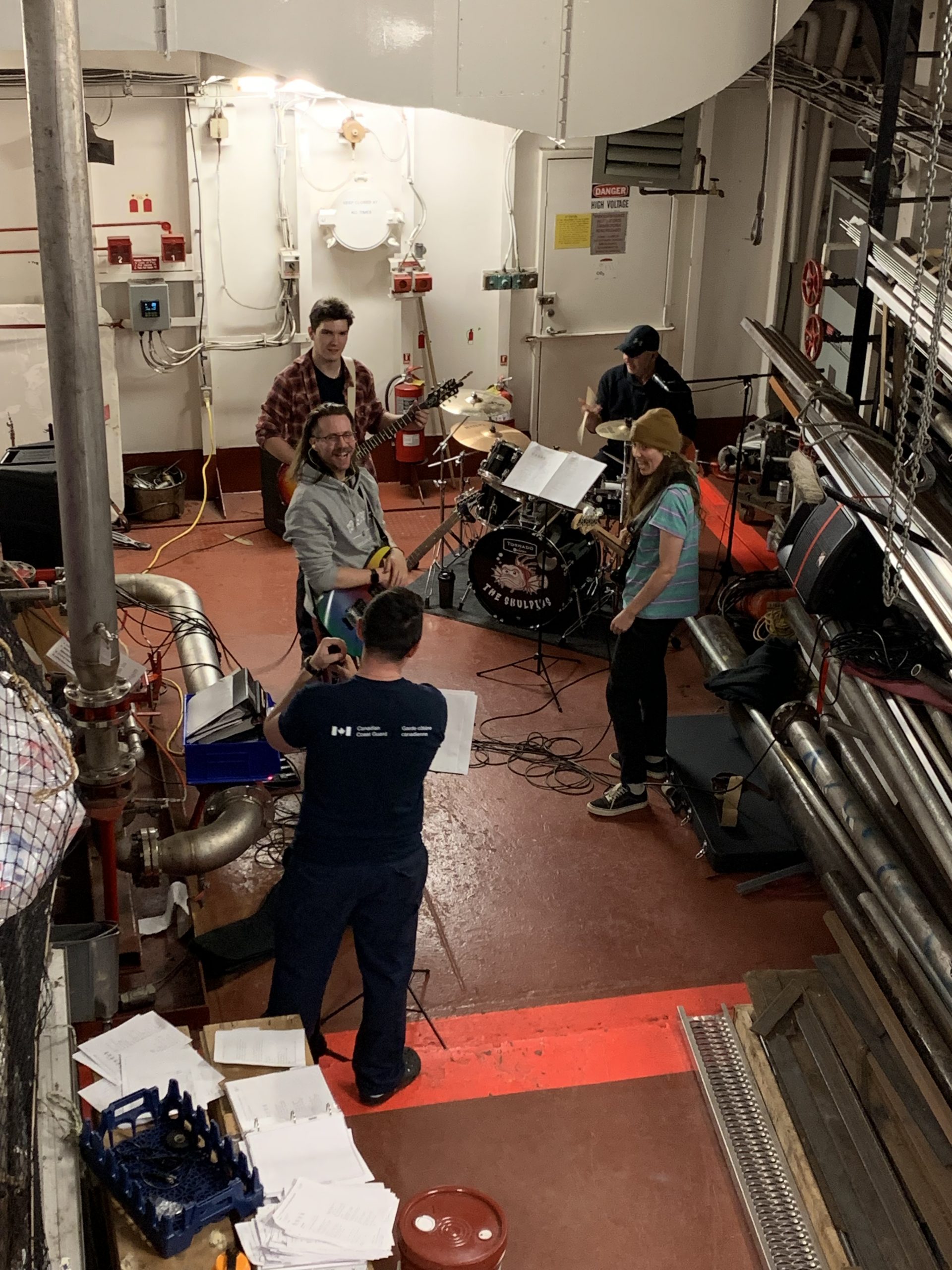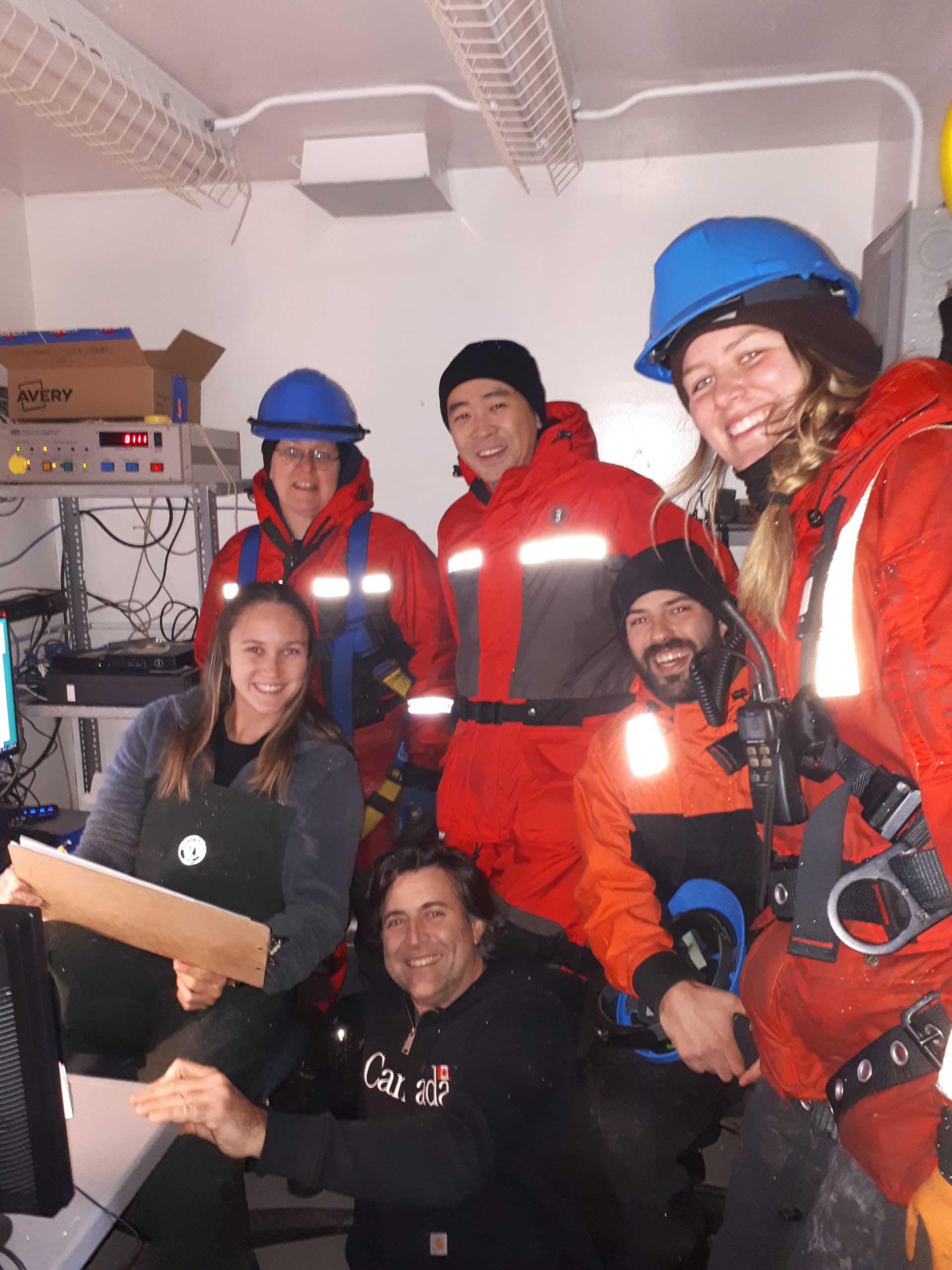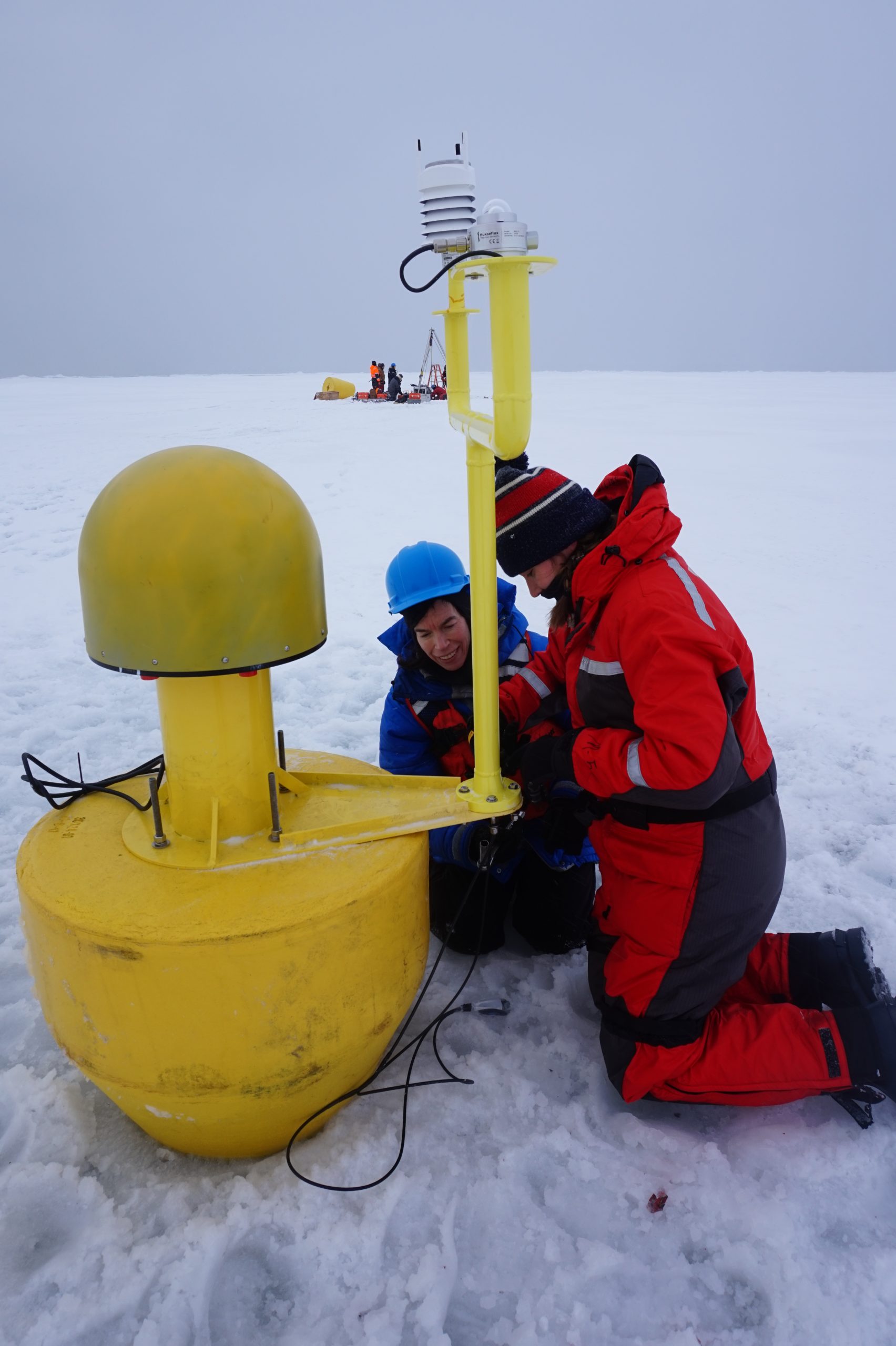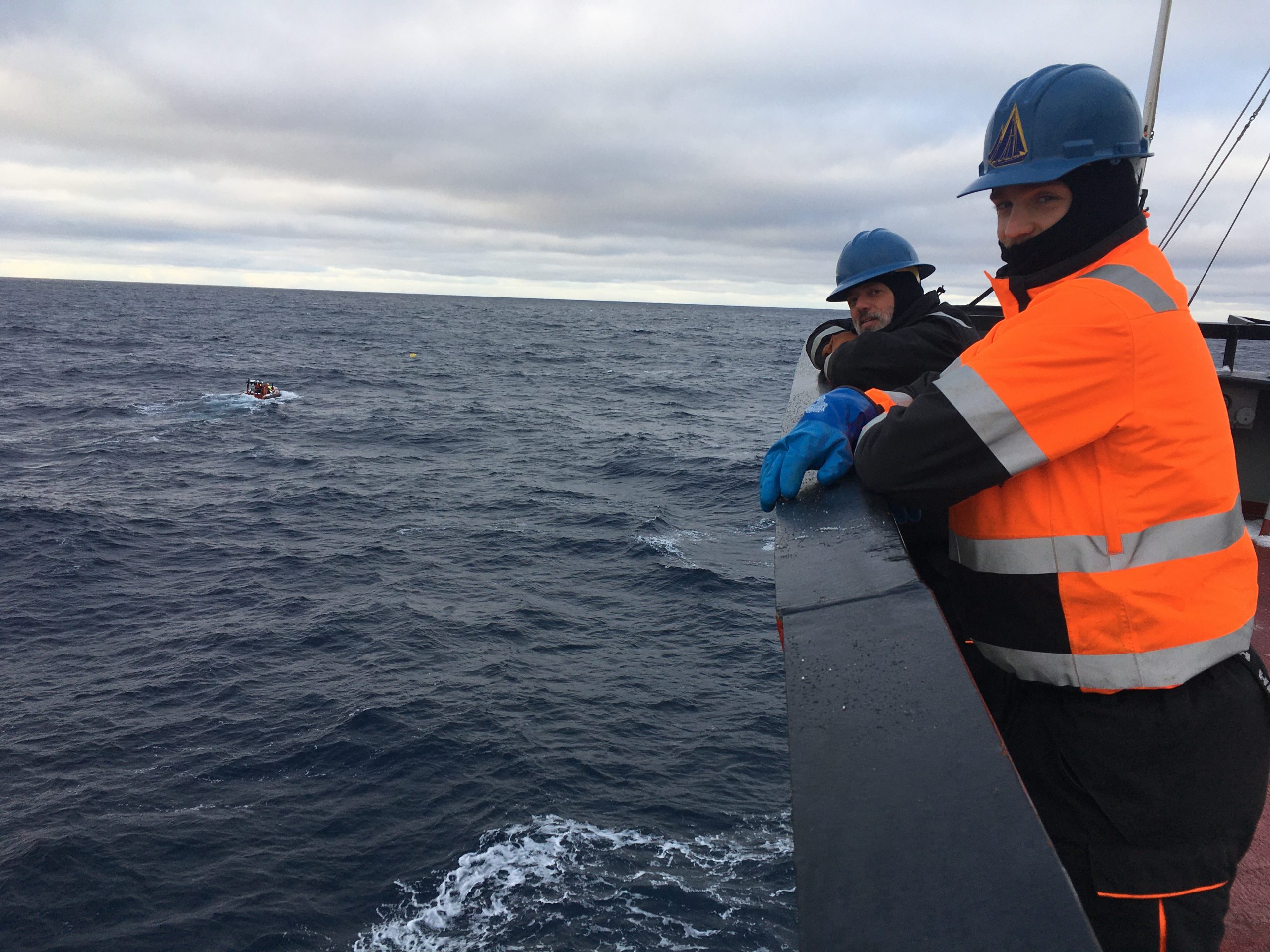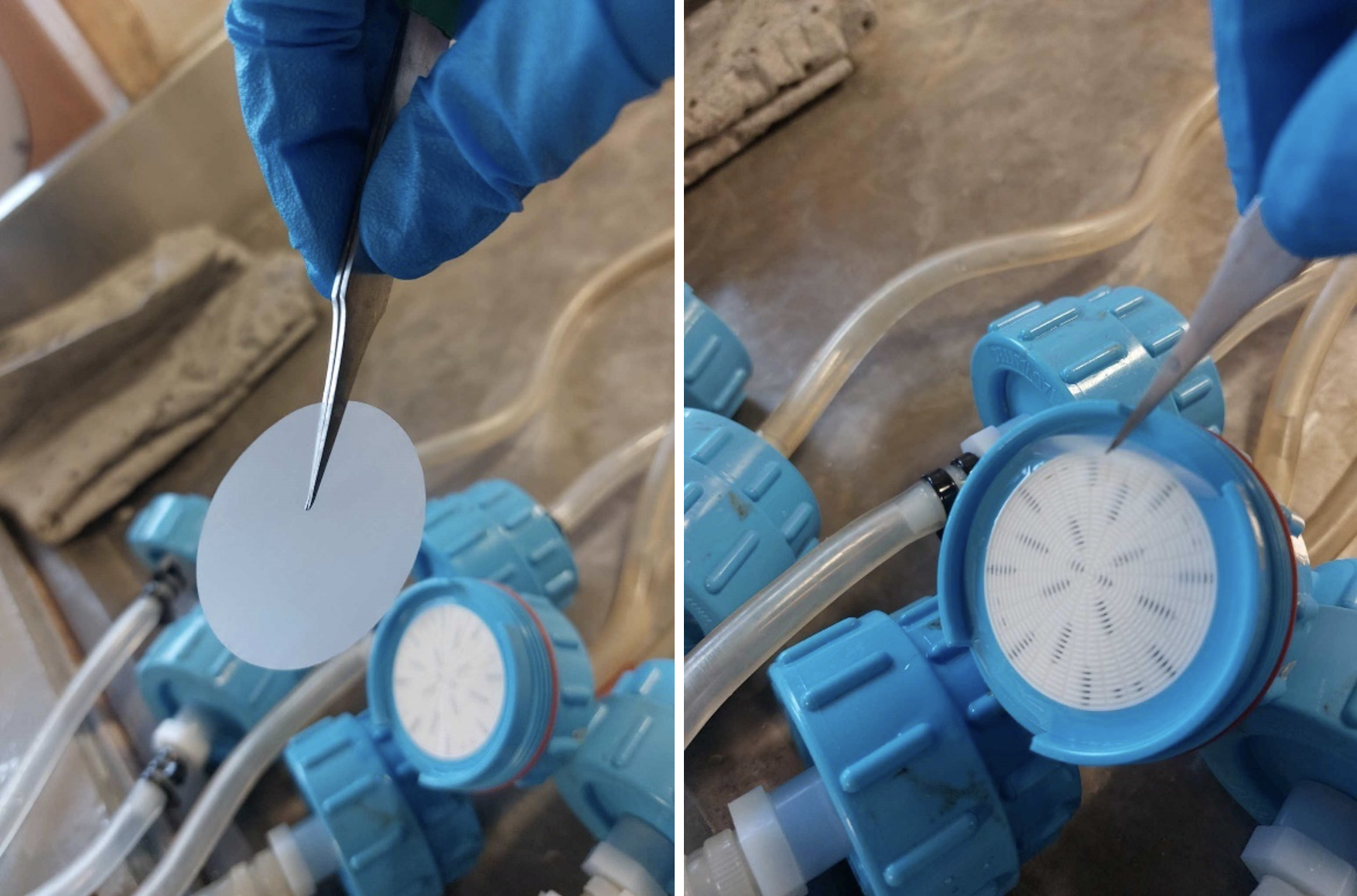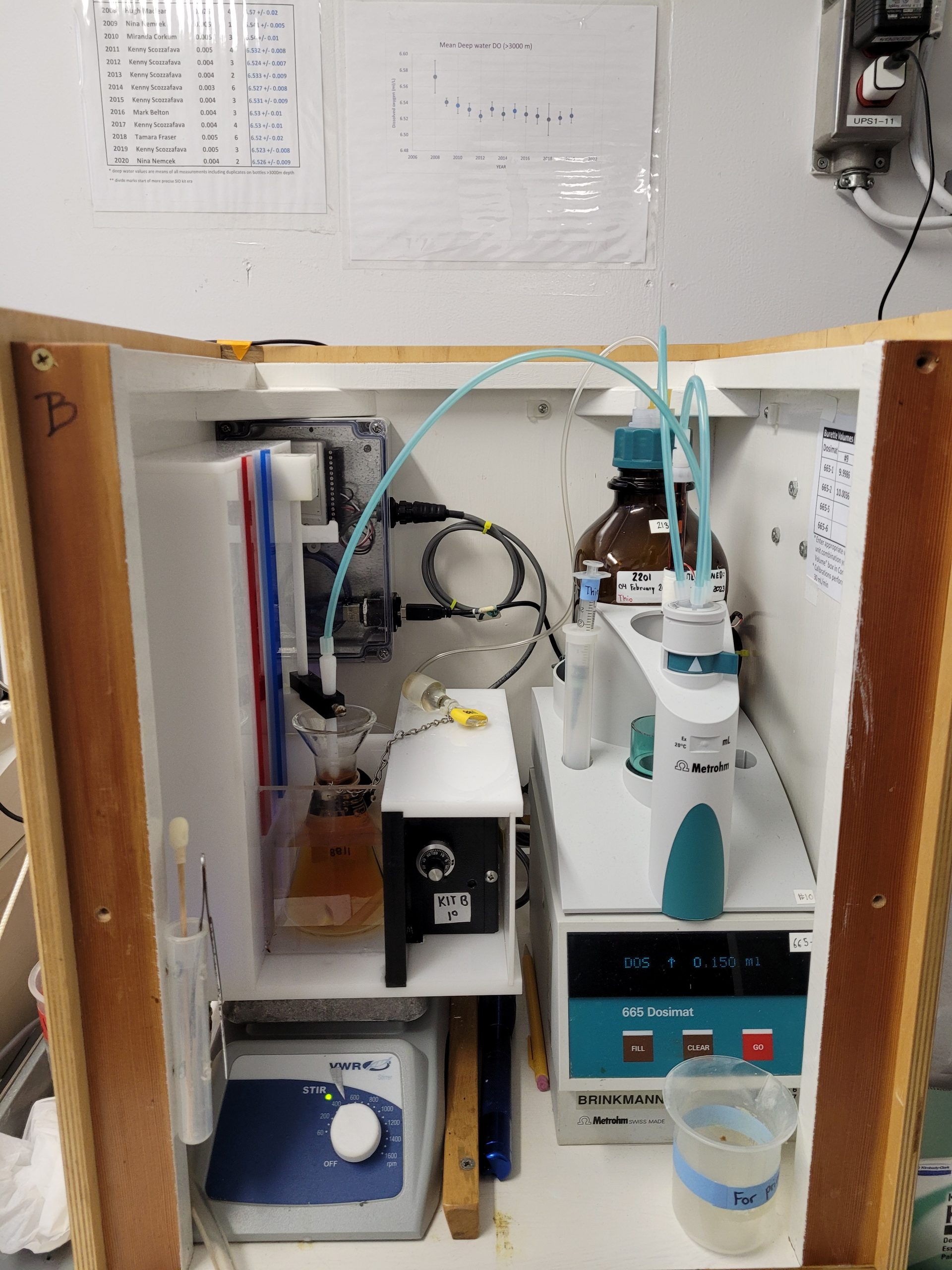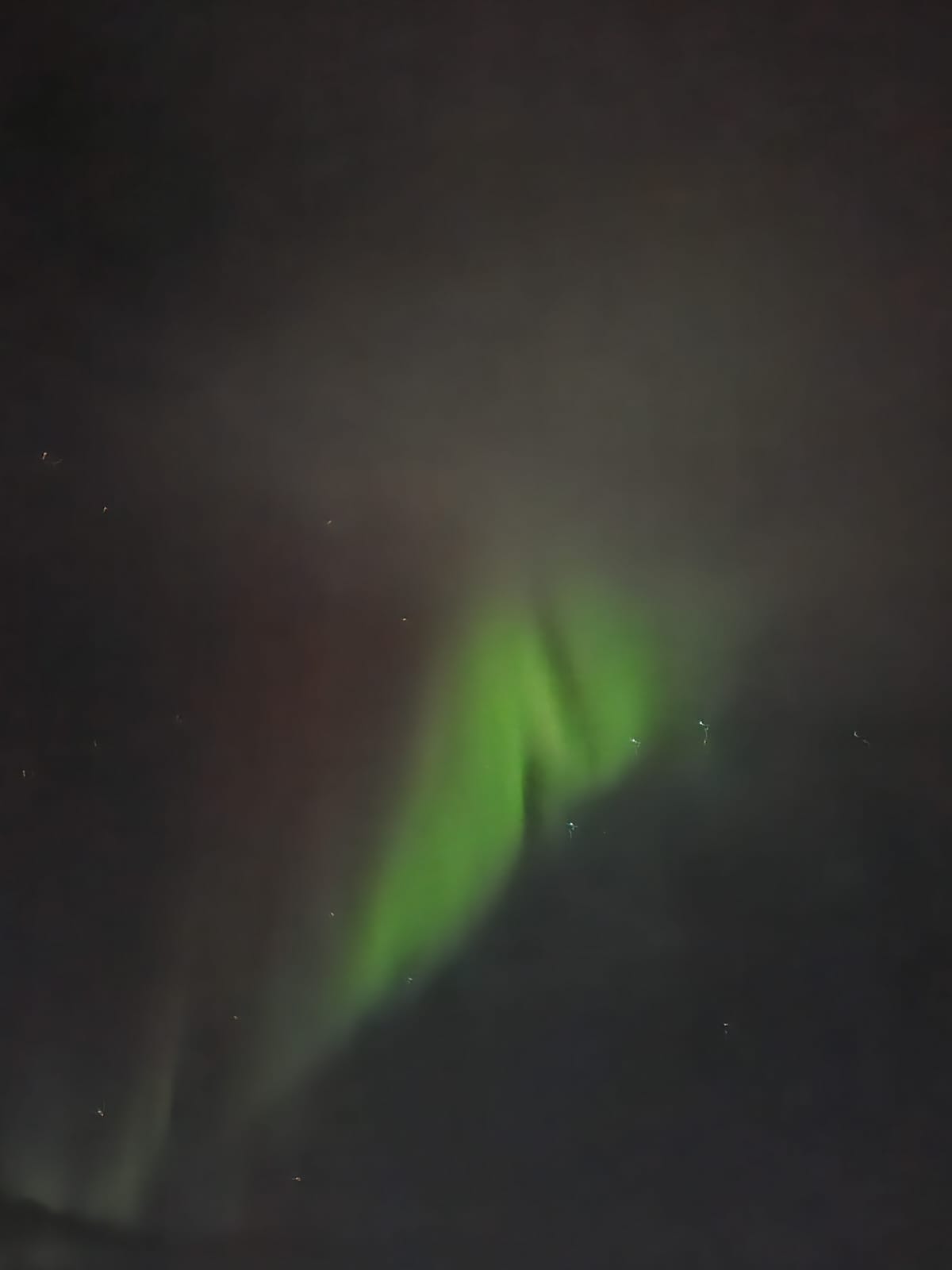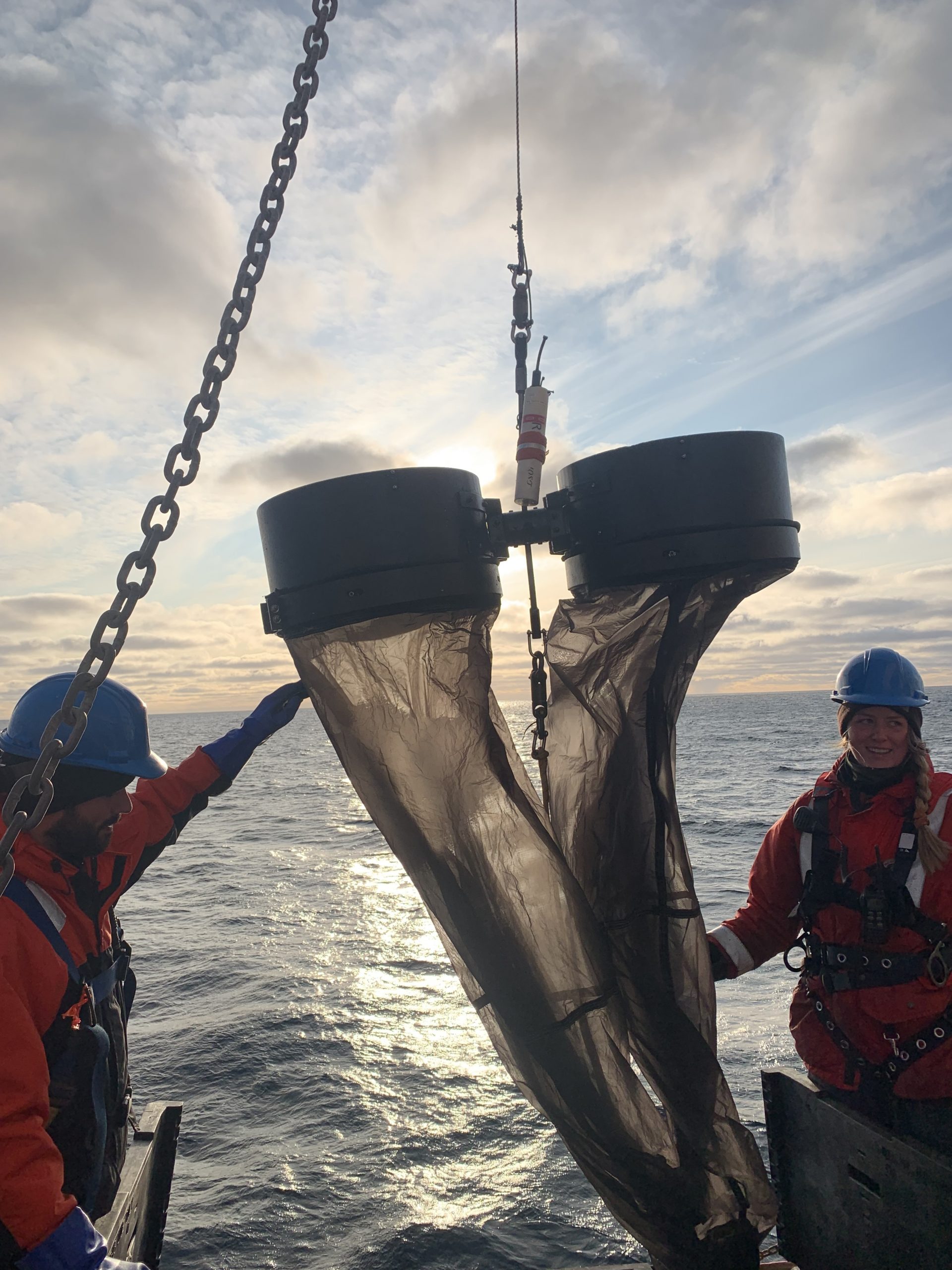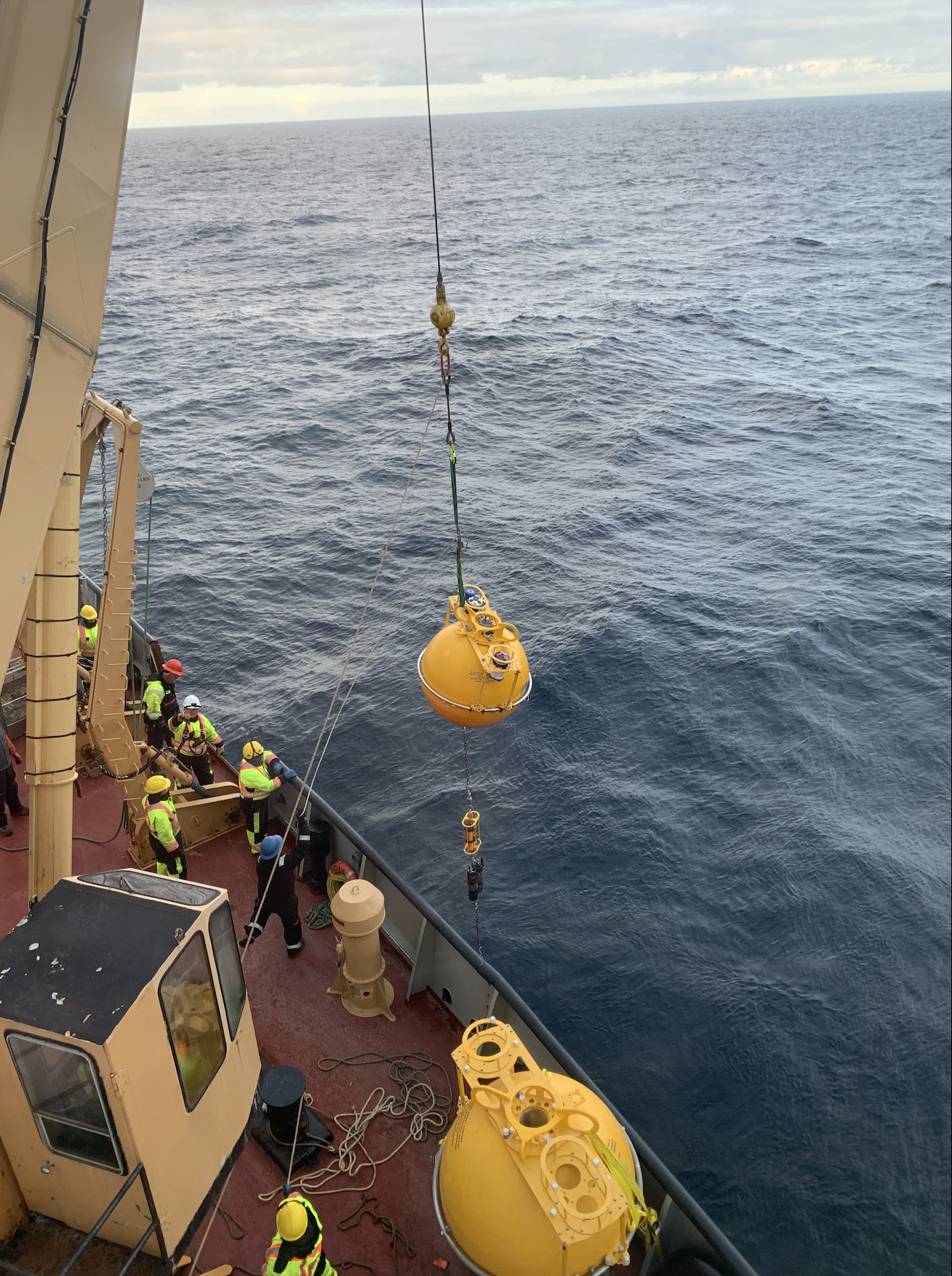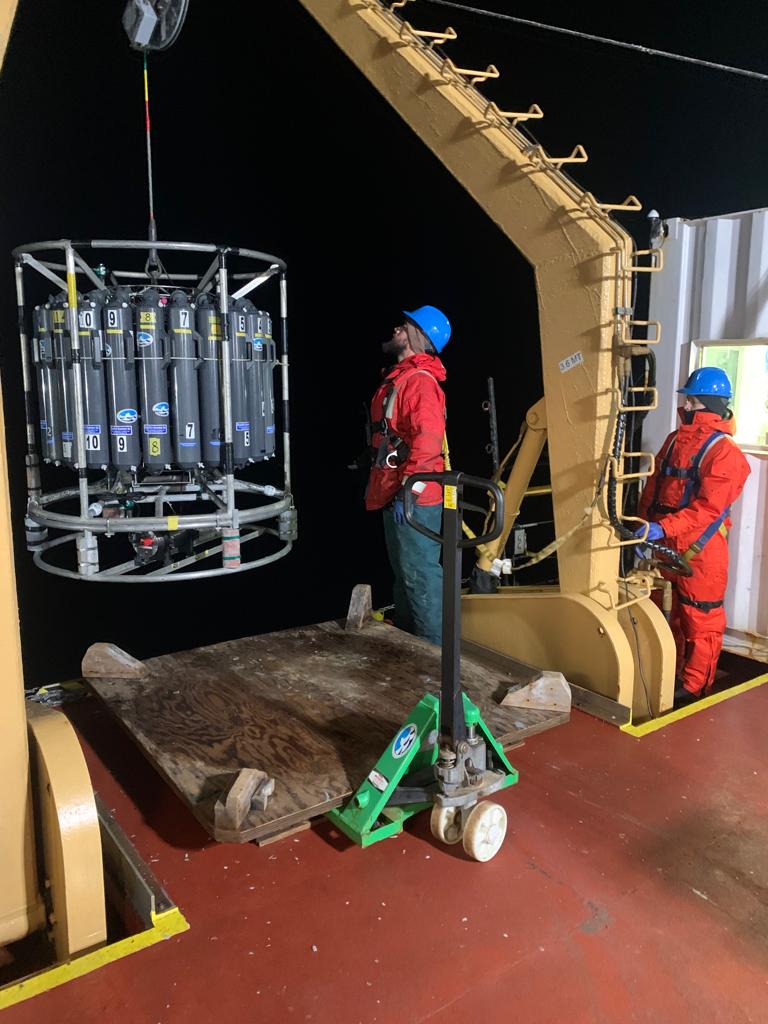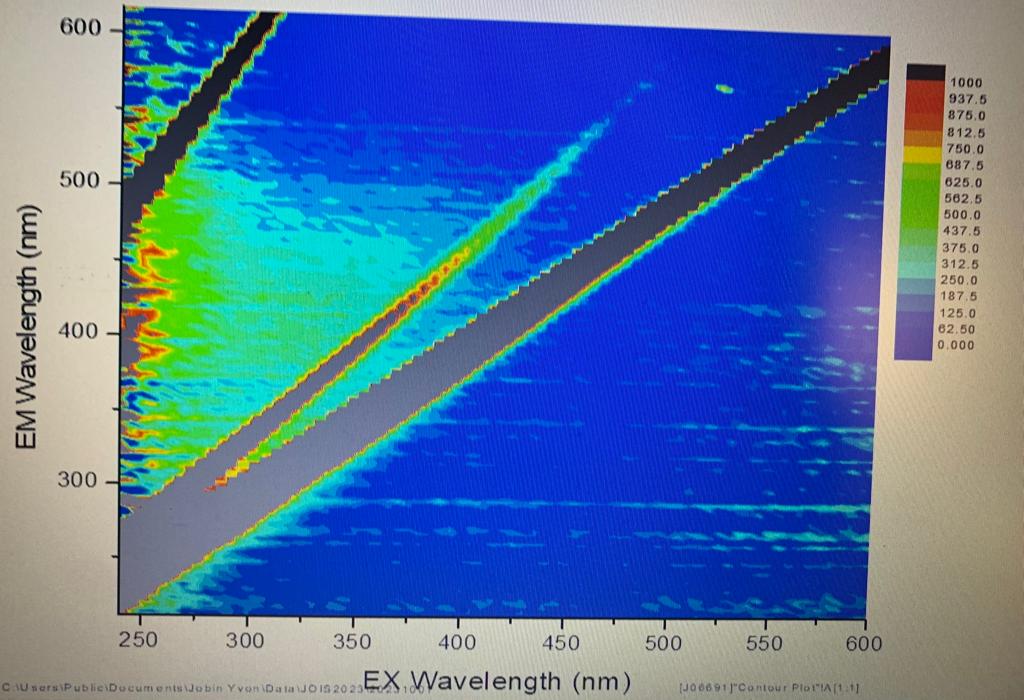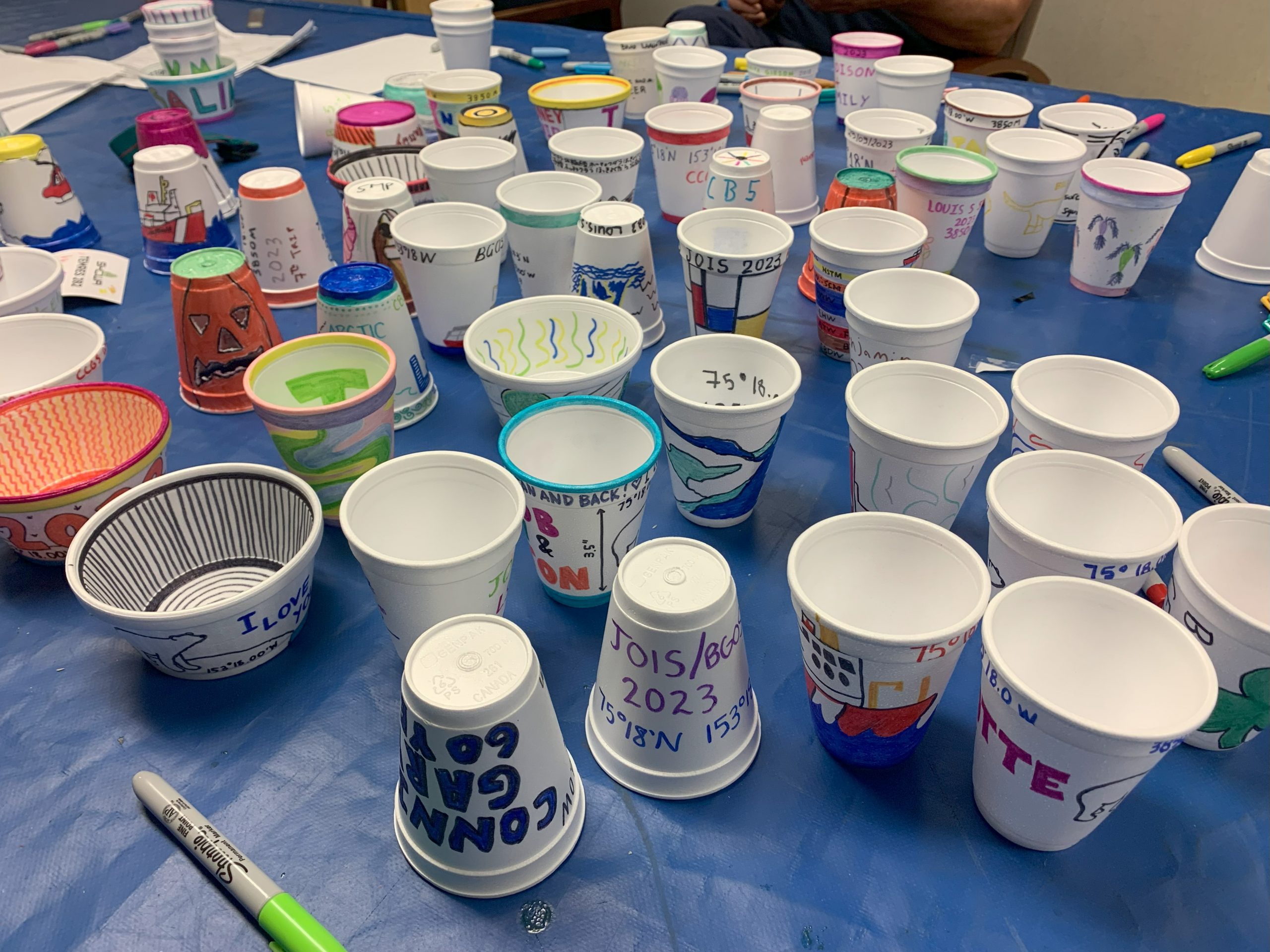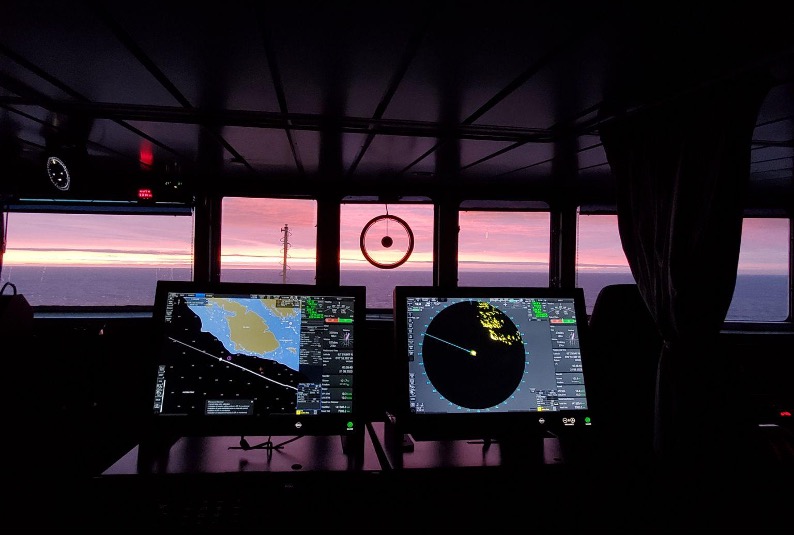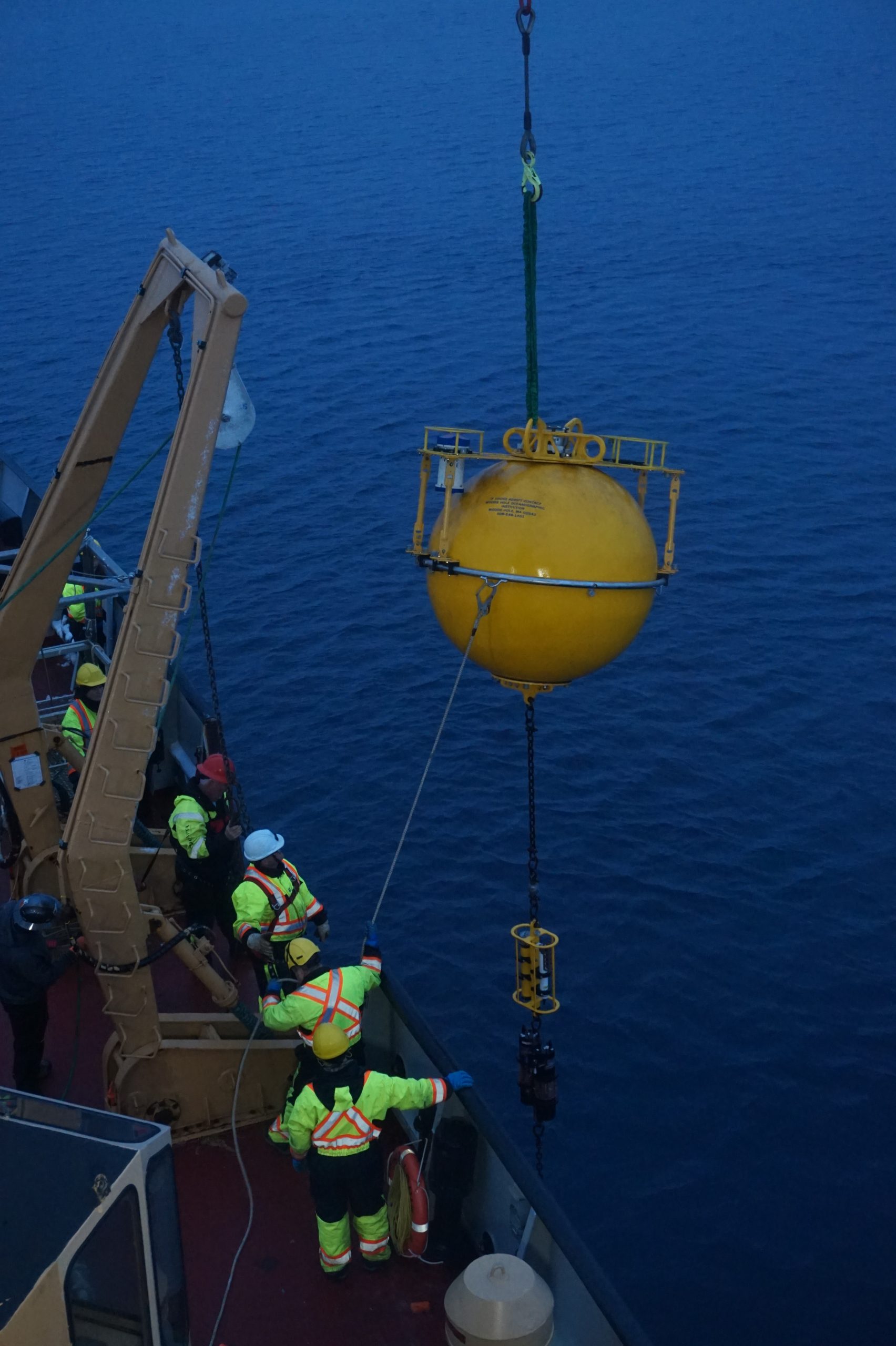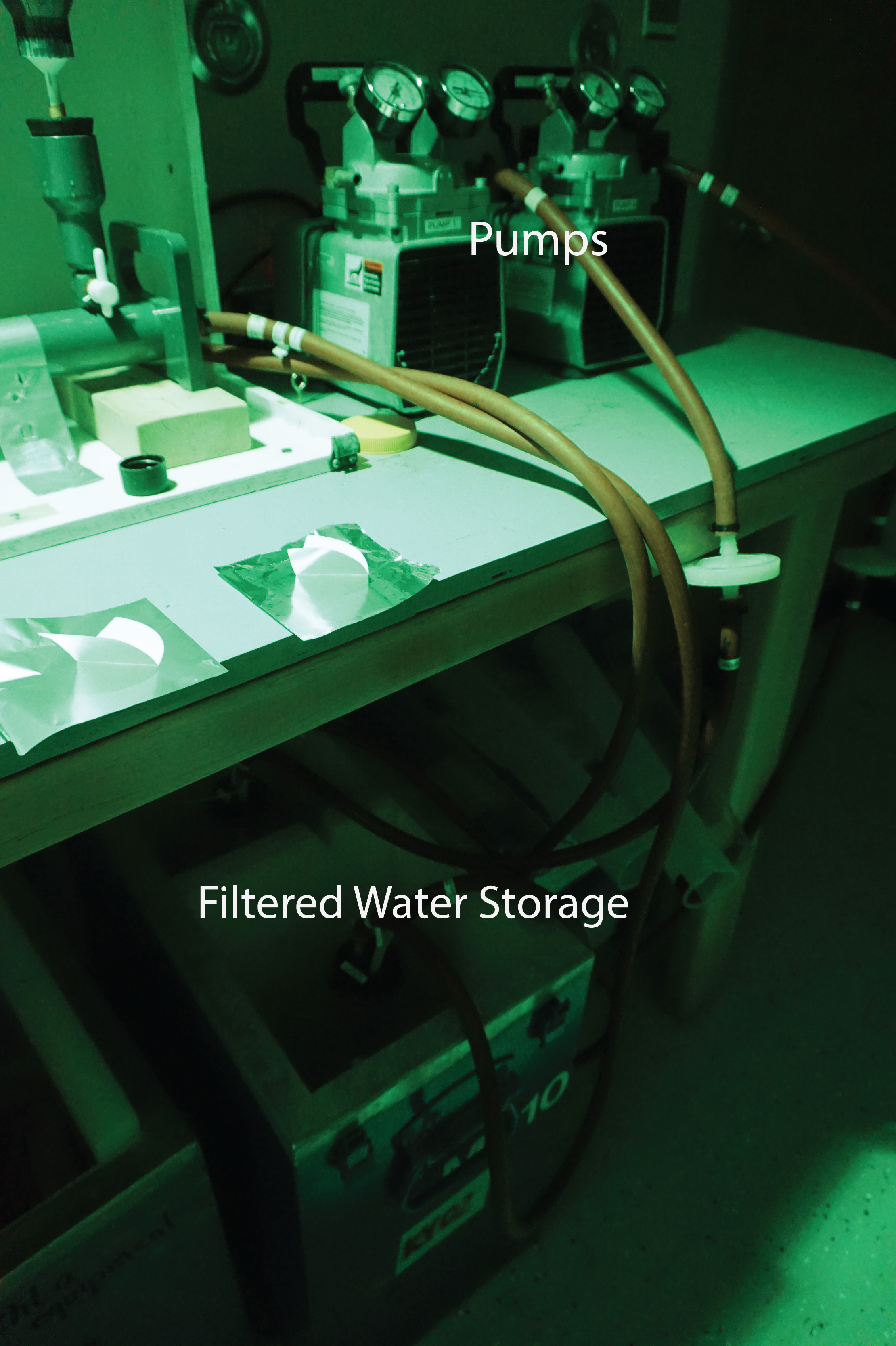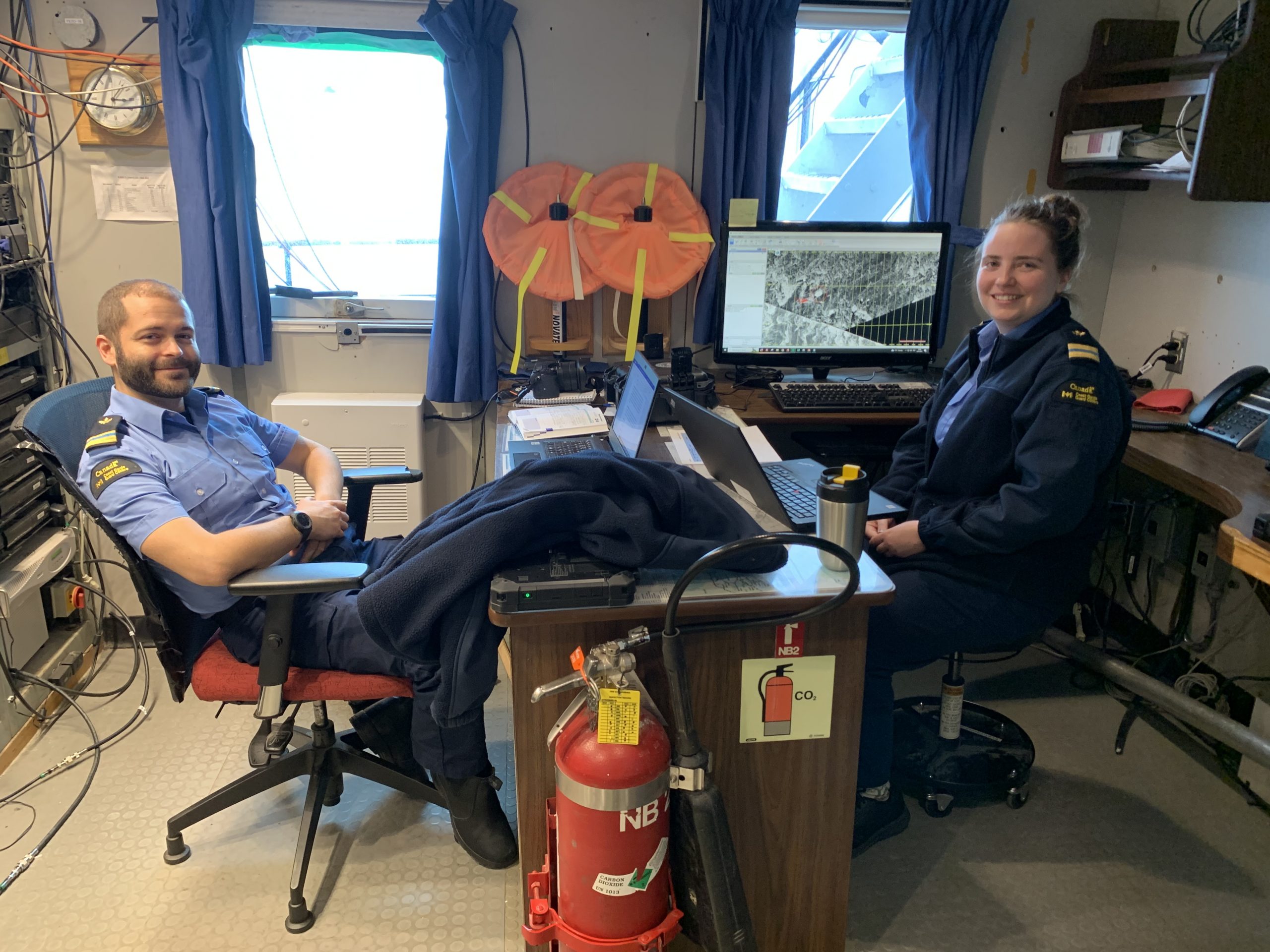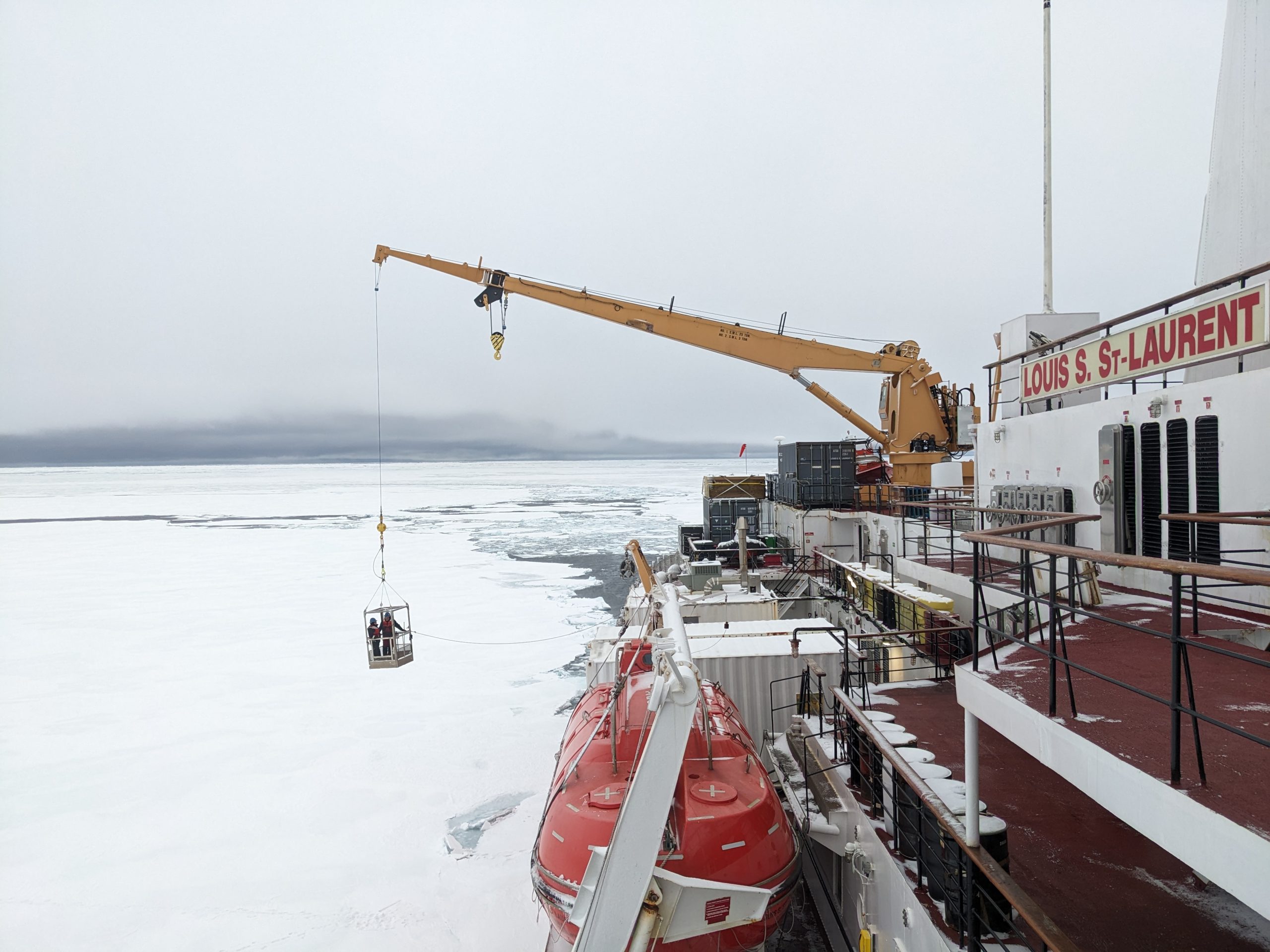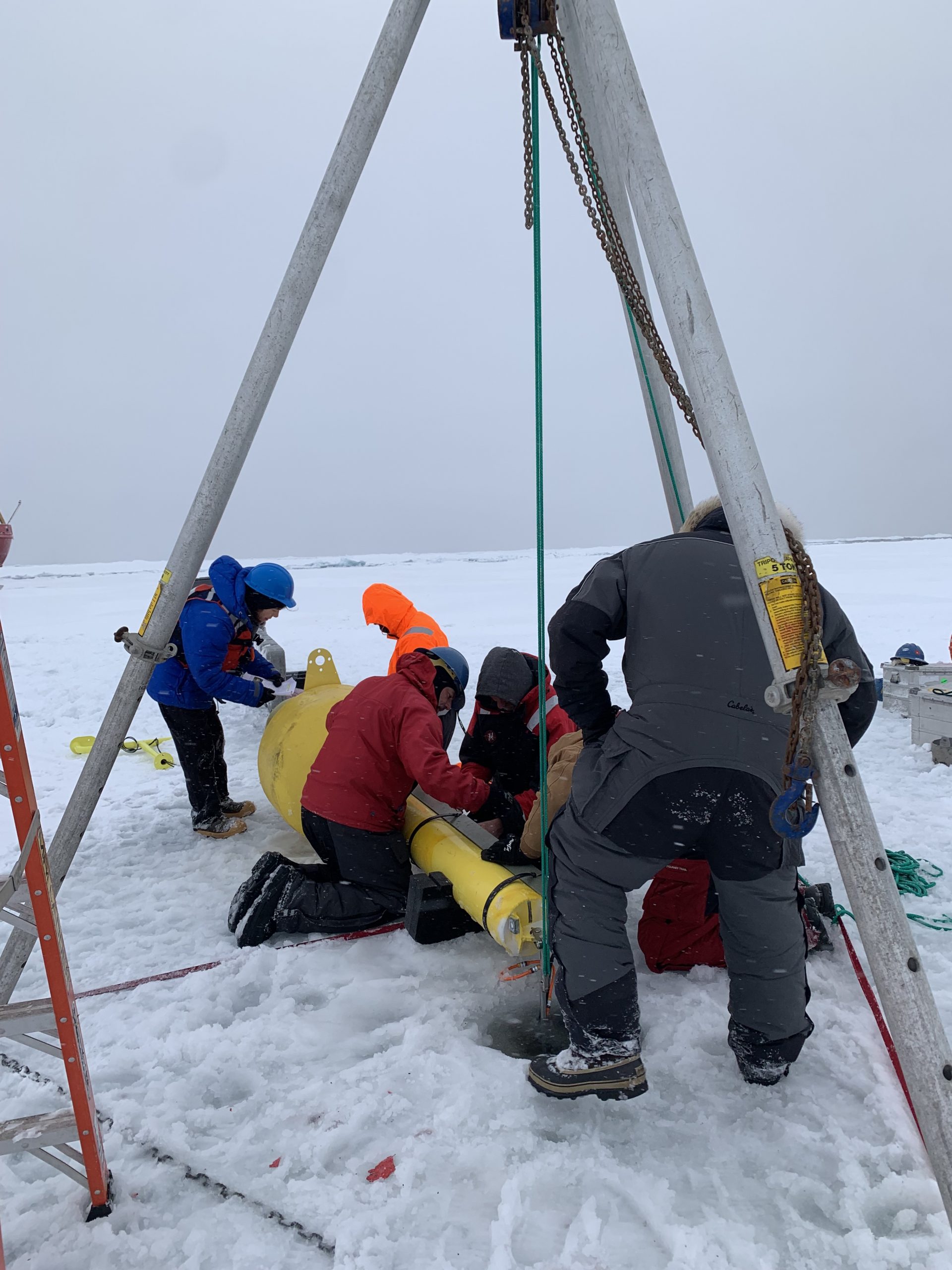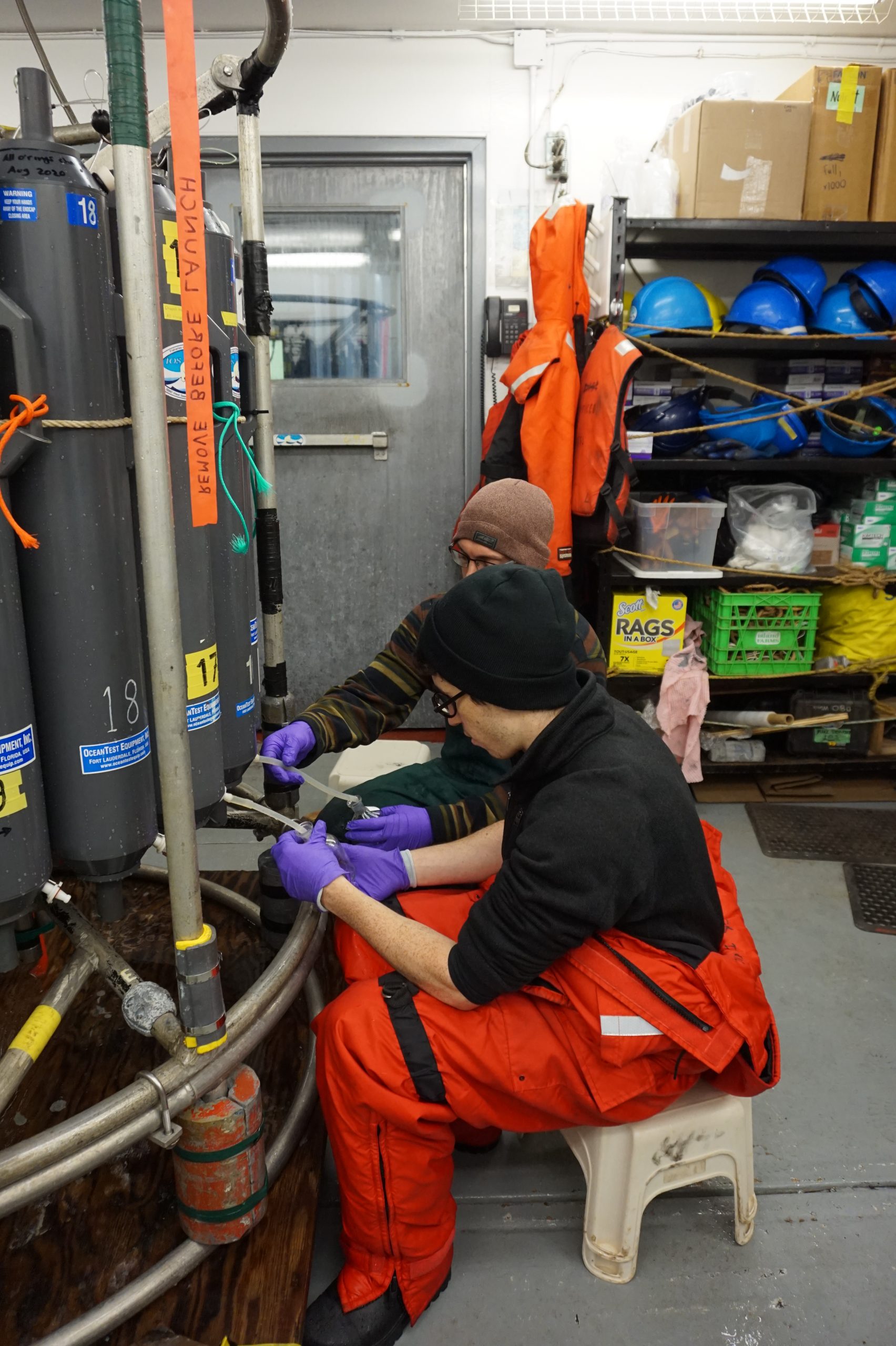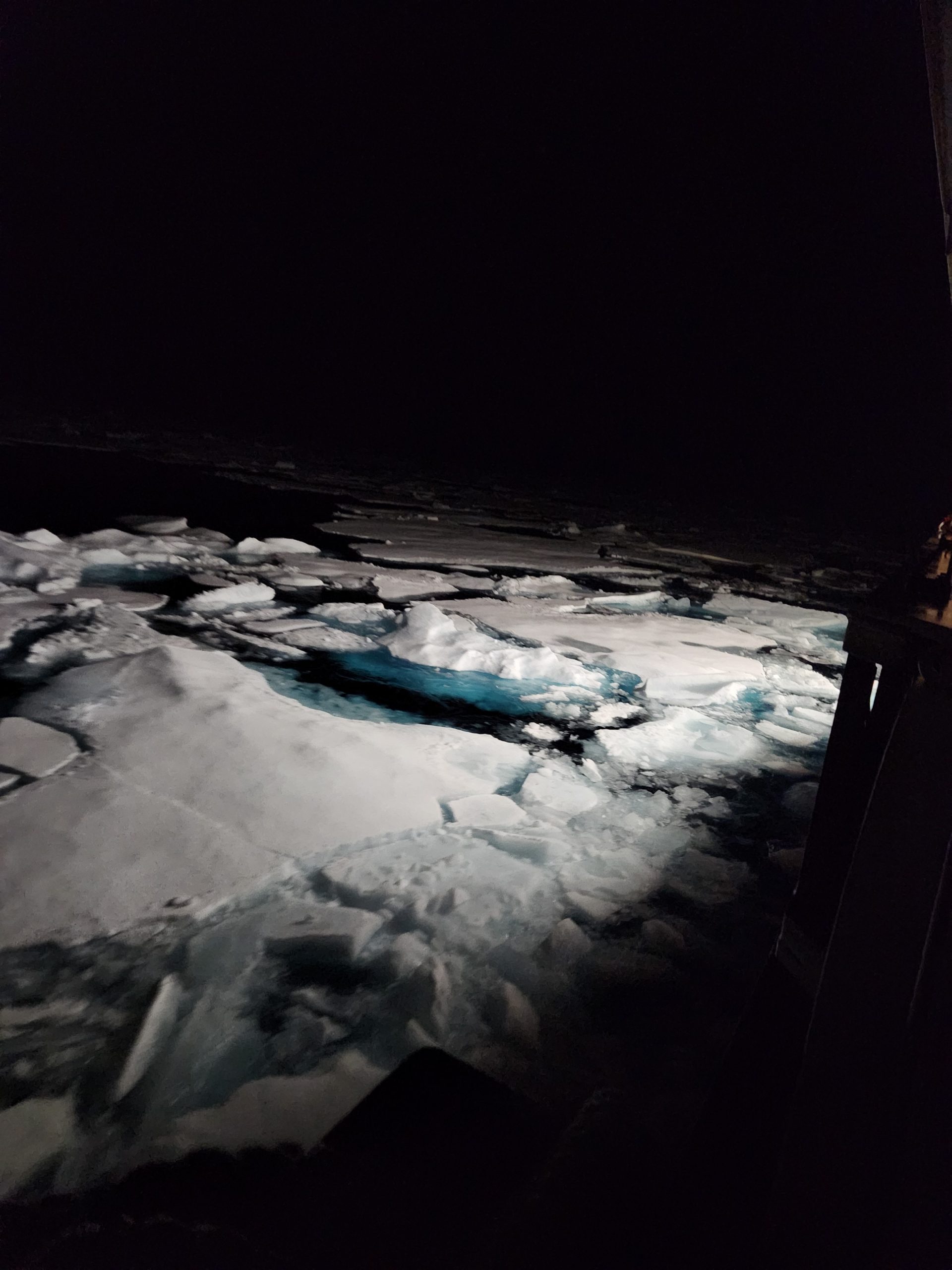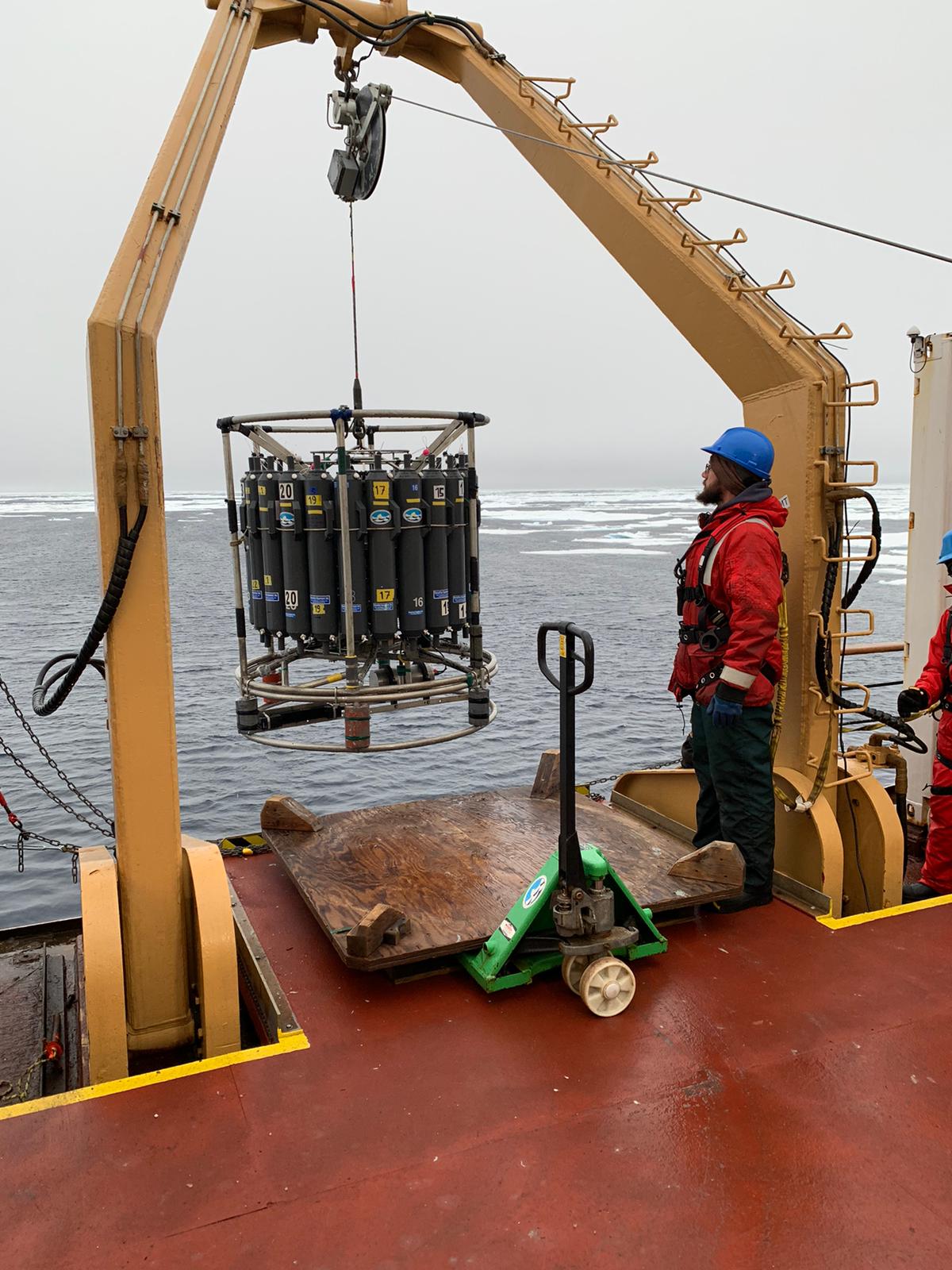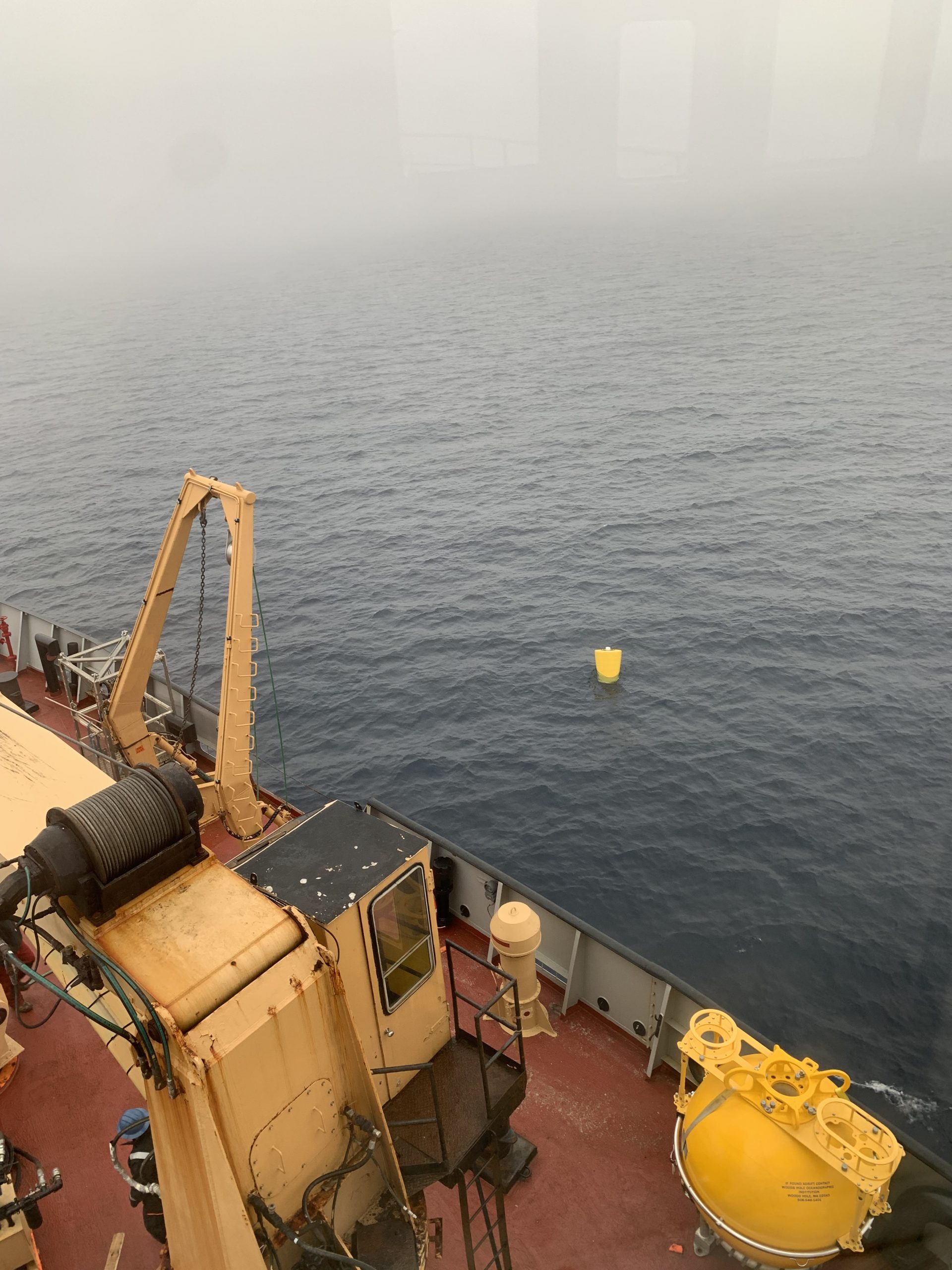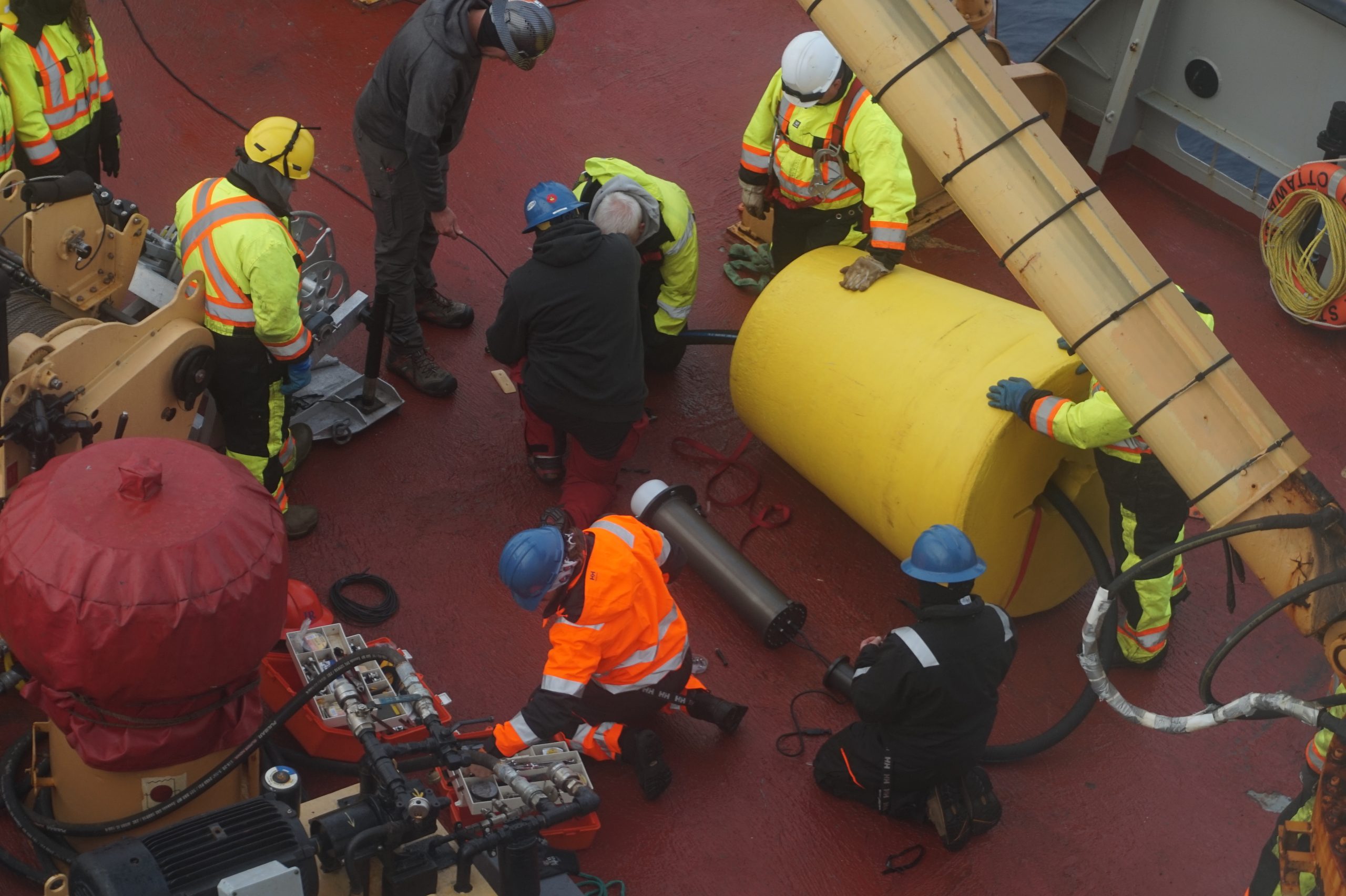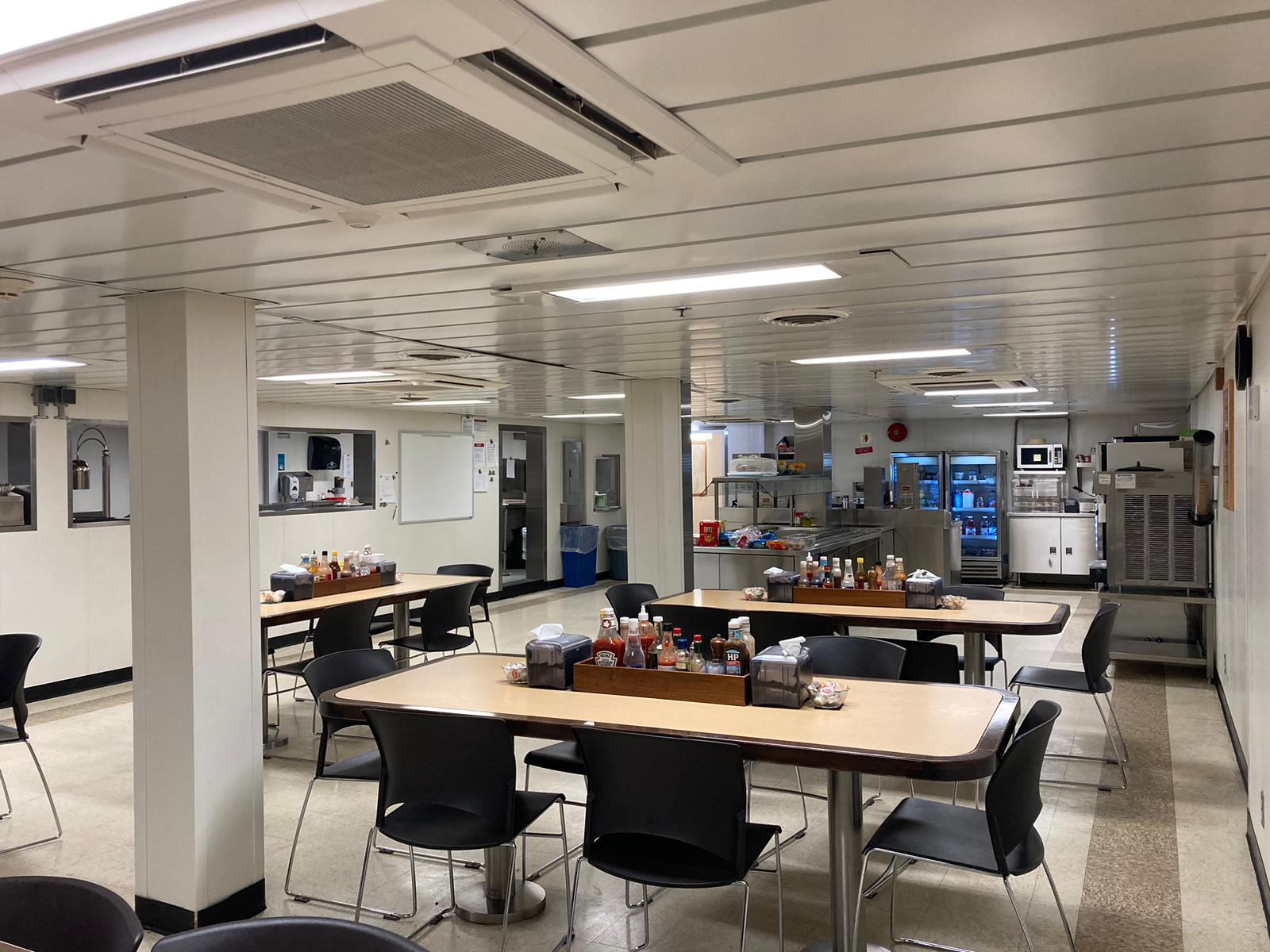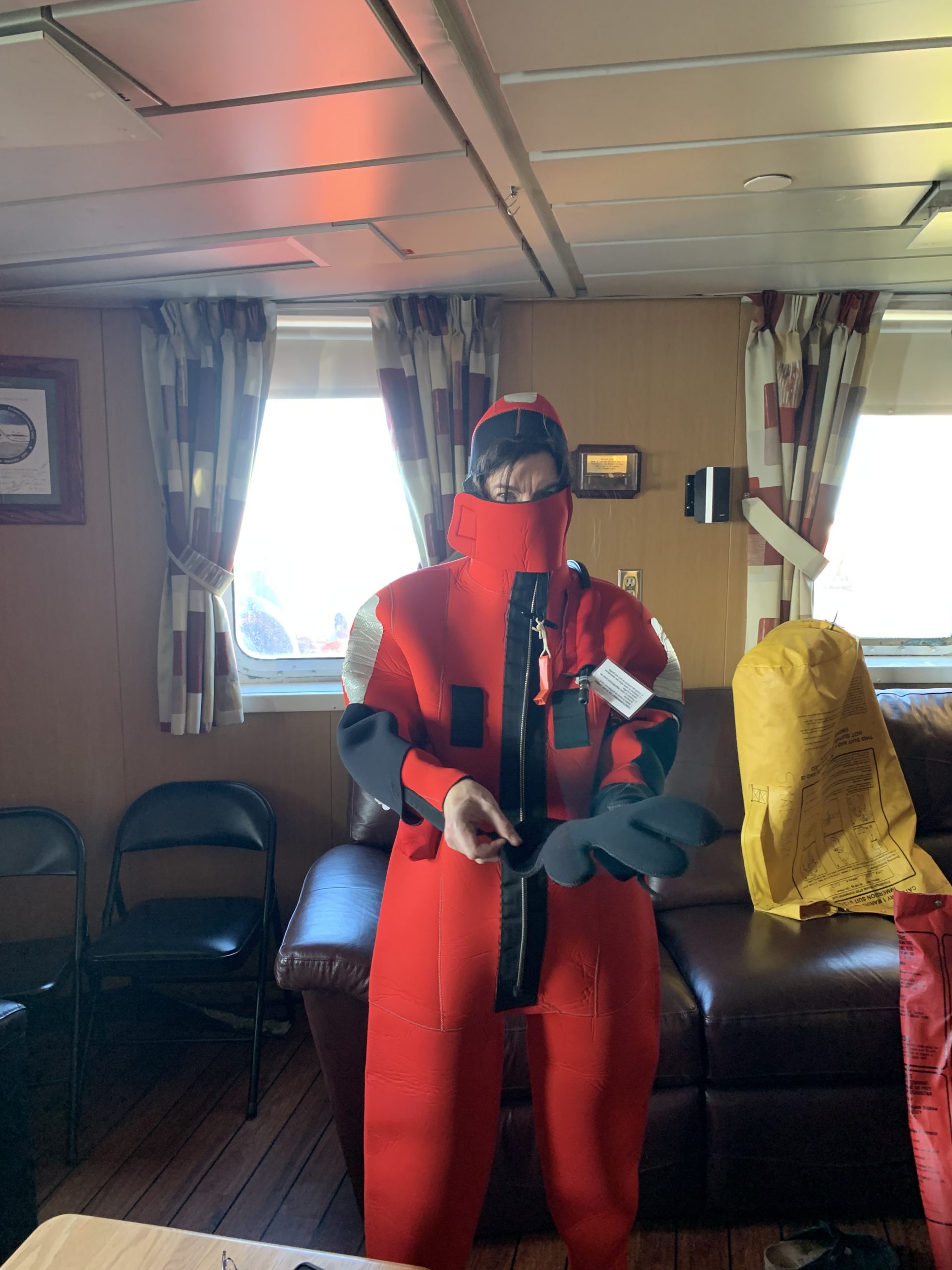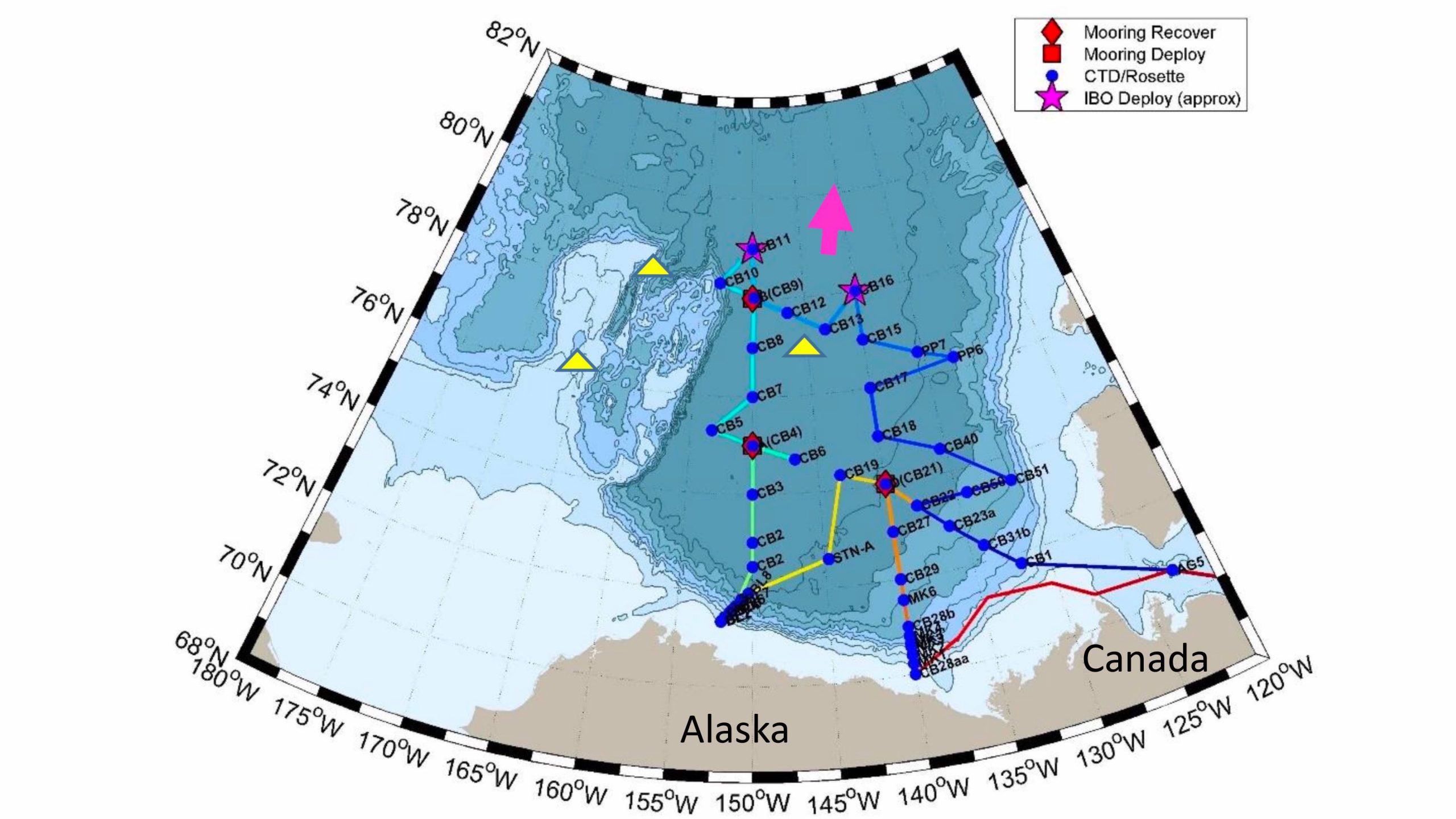2023 Dispatches
Dispatch 27: Closing Time
Today is our last full day aboard the Louis for the 2023 JOIS/BGOS expedition. All in all, this year’s cruise was successful and productive in all sorts of ways. We were able to maintain 24-hour operations due to the diligence of our science team and the Canadian Coast Guard crew, resulting in efficient and extensive water sampling and mooring/buoy operations. Throughout the expedition, we completed 55 CTD/rosette and 44 bongo net casts, ranging from as far south as 70°N to as north as 79.5°N.
Dispatch 26: Introducing The Louis S. St-Laurent’s one and only band: The Sculpins
Life aboard the Louis often consists of working long hours and each day can start to feel a little bit like the last. The crew members have come up with a unique way of keeping life interesting and creating a space to connect socially by forming a band called “The Sculpins.” Their practice space is nestled in none other than the belly of an icebreaker where you can find a full drum kit, guitars, mics, and a PA system. It is truly a one-of-a-kind rock and roll space.
Dispatch 25: Wrapping Up Science Operations
Last night we arrived at the last CTD/Bongo station of the 2023 JOIS/BGOS expedition around 8pm. Since we had been working our way down the “MK Line” (see dispatch 23) onto the continental shelf, this cast was only 50 meters deep, which was the shallowest cast of the cruise! When we arrived on station, there was a beautiful sunset. To celebrate the last rosette cast, an undisclosed member of the science crew, who happens to hold the role of co-chief scientist, played her French horn before we launched the rosette into the water. Since many of us had been begging her to play it since the beginning of the cruise, this was an exciting moment for those of us who were on deck! Once the beautiful French horn playing concluded, the rosette was lowered into the water for one last time. Because the cast was shallow, the rosette was back on deck within minutes, and then sampled. With that, we had finished up with CTD/Bongo operations, and began steaming back to Cambridge Bay.
Dispatch 24: The Turbulent and Chaotic World Under Sea Ice
It has been a week since our last two ice stations where we deployed multiple different buoys on the sea ice. Each is equipped with numerous sensors to measure ocean properties deep in the Arctic Ocean with some able to measure directly under the sea ice. Observations directly under the sea ice are extremely important for understanding and quantifying the fluid dynamics in a region known as the Ice-Ocean Boundary Layer (IOBL). When sea ice is moving relative to the ocean, it drags the upper layer of the ocean along with it. The region of water that is moving with the sea ice is the IOBL. The IOBL is a host for many weird phenomena (with most due to us being on a rotating planet) like, for example, sea ice moving in a direction 45° to the right of wind.
Dispatch 23: One Last Buoy Recovery: TOP number 4
We are steaming south down the 140°W longitude line towards the continental shelf again to begin another array of coastal CTD/bongo stations (like the Barrow Line in Dispatch 20). This line of stations is called the “Mackenzie Line” or “MK line” for short since these stations are located close to the mouth of the Mackenzie River. Over the past few days, the buoy team has been keeping a close eye on the GPS location of two potential buoys that were candidates to be recovered, as they were in the general vicinity of our cruise track. These buoys were one Ice-Tethered Profiler (ITP number 122) and one Tethered Ocean Profiler (TOP number 4). ITP 122 and TOP 4 were both deployed on the same ice floe (at 79°N 135°W) in September 2021. The two buoys drifted together throughout most of their time in the Canada Basin but started to separate some months ago. In the past week, ITP 122 went rogue and started moving at 80 cm/s, which is very fast considering ITP drift speeds are typically only around 10 cm/s! Some of us were joking that ITP 122 was catching a ride with a speedy whale. It’s still unclear why the buoy is moving so fast, and we may never know. Because of ITP 122’s escape from our vicinity, it no longer made sense to attempt recovering both buoys. So, we set our sights on recovering TOP4 (which happened to be only a few miles out of our way along the MK line).
Dispatch 22: It’s a Small World, After All
Fungi, bacteria, archaea, and protists are all members of the microscopic organisms that dominate the planet. Microbial life also represents the greatest biological diversity on Earth. Despite a fascinating variety of metabolisms, and having colonized every environment known to us, they are still far less understood than larger forms of life, like animals and plants. Many microbes are resistant to culturing and so those that have been most thoroughly studied are those that are easily cultured in a lab setting -with greatest effort placed into the study of human pathogens. Microbial taxa are also alarmingly abundant, and thousands of species might exist in a single drop of water. The challenge presented to microbial ecologists then is how to study a microbial community when traditional methods won’t do. This can be accomplished through genomics. Studying the genome of a microbe provides insights into their metabolism, adaptations to their environment, and their evolution. Genetic sequencing and genome assembly techniques have become more effective, inexpensive, and capable of reconstructing a large number of genomes from an environmental sample with reasonable confidence; they are therefore great and accessible tools to explore the microbial world.
Dispatch 21: Oli Oli oxygen!
Do you like being able to breathe oxygenated air? Well, I have some good news for you! The ocean is full of oxygen! Dissolved oxygen concentrations are primarily set at the sea surface where the ocean interacts with the atmosphere through air-sea gas exchange. The amount of oxygen retained by the ocean depends on the temperature and salinity properties of that specific water body. Colder and fresher water can retain dissolved gases better than warmer and saltier water. In addition to atmospheric mixing, dissolved oxygen is produced by tiny plants called phytoplankton that live in the upper few meters of the water column, where the sunlight can penetrate. They photosynthesize using energy from the sunlight, plus carbon dioxide and water to produce oxygen and sugar. Since the phytoplankton need sunlight to photosynthesize, oxygen concentrations are highest near the sea surface. Oxygen is then consumed during processes like respiration (animals breathing) and decomposition (breakdown of organic matter by bacteria). Those processes most commonly take place deeper in the water column, so it is normal for the oxygen concentration to decrease with depth.
Dispatch 19: Bingo Let’s Go for the BONGOs
At every station we are doing two different activities: a CTD/rosette cast and bongo nets. A bongo cast consists of catching zooplankton and phytoplankton in the top 100 meters of the ocean. The Arctic Ocean might seem like a biological desert, but it isn’t! The Beaufort Gyre region is full of nutrients thanks to the many rivers that flow into it. The nutrients allow for primary production (that is, photosynthesis and phytoplankton population growing), which benefits the whole food chain.
Dispatch 18: Redeployment of Mooring A
Two days ago (on September 30th), we recovered BGOS Mooring A (at 75°N 150°W). Once a mooring is recovered, we would typically steam to another science station to do a CTD/rosette cast, and then return to the mooring site 24 hours later for its redeployment. The time in between the recovery and the re-deployment gives the WHOI team a chance to reprogram the mooring instruments to ensure they are ready to be sent back down to measure data for the next year. However, the day after the mooring recovery, sea conditions were extremely rough at the Mooring A site. The BGOS moorings are deployed by lowering the anchor down first, followed by the instruments and the top float, so there is an extremely heavy load hanging over the side of the ship for several hours. Because of the rough seas with large swells (2.5-3.5 meters tall!), the conditions were not ideal for a mooring redeployment. So, after recovering the mooring, the science team planned to steam to an extra CTD/rosette station, to give an extra day in between the mooring recovery and its redeployment while we waited for conditions to calm. We arrived back at the mooring site late last night. By the time the mooring operations began this morning, the weather and sea conditions were more favorable for the deployment.
Dispatch 17: Good Morning, Night Watch!
Science on board the Louis S. St-Laurent is 24/7. This means that whenever we arrive at station, scientists must be ready to deploy their instruments, with help from the crew of course. To make sure that everyone is rested, some scientists are put onto a day shift (noon to midnight) and others on the night shift (midnight to noon). Each shift needs someone who can operate the CTD computer and someone to lead on deck as well as extra hands on deck to help with operations like bongos. I am on the night shift with four other people: Chris (who is our watch leader), Sarah, Sam, and Justin. When the cruise first started, we all had to wrestle with our sleep schedule so that we could sleep during the day and be ready to start working at midnight. Some days are still harder than others, but once you’re up and have some coffee, it’s easier to get the “day” going. Another thing that is different about the night shift is that there are fewer people around. Only some people get put onto day vs. night shift, and the others are more on their own schedule, or they are up to sample from the CTD and process their samples and squeak in naps during the in between times. Luckily for us, the five of us get along well so we are content to work and hang out together.
Dispatch 16: Why Does Dissolved Organic Matter Matter?
Dissolved organic matter (DOM) is made of a large mixture of complex molecules that originate from the decomposition of living organisms (plants, bacteria, animals…). Since DOM is mainly made of carbon, its behavior in the environment will greatly influence the carbon cycle under climate change. This is why we are measuring the fluorescent dissolved organic matter (FDOM) here in the Arctic Ocean. Even though FDOM only represents a tiny fraction of the entire DOM pool, it can provide us with crucial information including molecular weights, concentrations and resistance to decomposition.
Dispatch 15: Shrinking Cups
We have just reached our deepest station of the trip: CB5 (75N and 153W) with a staggering depth of 3850m! That’s deeper than five Burj Khalifas (the tallest building in the world) stacked on top of each other! With it being our deepest station, it is JOIS/BGOS tradition to attach a bag of Styrofoam cups, each individually stylized by the coastguard and science crew, to the rosette during its data collecting cast. Some styles included sea ice, polar bears, loved ones’ names, trippy designs, and other various creatures. As the cups delve deeper and deeper, they will be crushed and compressed by the enormous amounts of pressure induced by the weight of the Arctic Ocean. When the cups resurface with the rosette, they will be completely deformed, providing to be a neat souvenir of our time on the Louis 2023!
Dispatch 14: A Day in the Life of a Watchkeeping Officer
Welcome to the Bridge on the Louis S. St-Laurent! After completing a Watchkeeping Mate certificate from an accredited program, this is the office of a Watchkeeping Officer!
Here during a 24-hour period the Watchkeeping Officer works a rotating schedule:
- 4 hours on watch
- 4 hours completing day work
- 4 hours off
- 4 hours on watch
- 8 hours off
Dispatch 13: We Came Back for You, Mooring B!
Today, we recovered Mooring B which was deployed on last year’s JOIS/BGOS cruise! We began around 5 am when we arrived at the location where Mooring B had been deployed last year. Once we got within a kilometer or so of the mooring, we used a deck box to communicate with the instrument. The deck box sends out a signal, and if the mooring is within range to receive the signal, you will hear a ping back on the deck box. Once you receive this ping information from a few different locations, you can pinpoint the mooring’s precise location. We found that the mooring was a little over 400 m from where we recorded it had been deployed last year. With this understanding, we got the ship closer to the mooring and once everything was all set, we sent a release code from the deck box to the mooring. The mooring is designed such that there is a 3800-meter line with a weight on the bottom, a buoy on the top, and instruments along the line. In between the bottom-most instruments and the weight, there are two releases. The releases hold the line, instruments, and buoy to the weight. When a release receives the release code from the deck box, it knows to let go of the weight such that the buoy can pop to the surface (leaving the weight behind), and we can recover everything attached.
Dispatch 12: Filtering Chlorophyll in the “Green Room”!
After we collect water samples from each CTD cast, some of the samples get processed on board. In a small lab tucked back in a corner, we have a station set up to filter chlorophyll-a out of samples. Chlorophyll-a is a pigment that allows algae to photosynthesize, where sunlight is used to generate oxygen and energy. Because it requires light, we only take water samples from the Niskin bottles tripped relatively close to the surface of the ocean where light can penetrate. Chlorophyll-a concentrations are valuable in giving us an idea of the level of primary production (photosynthesis) that is happening in the Arctic Ocean, something that is difficult to quantify. Once we collect the samples, we go straight to the lab to run the water samples through a filter. Because the amount of chlorophyll is sensitive to light, we collect the water samples in brown bottles so no light can enter. We also do the filtering in a room with only green light, hence the “green room” and the green tint on all the photos.
Dispatch 11: The Inside Scoop on the Ice Specialists
Today we spent another day on the ice conducting research and deploying and embedding ocean instruments into the ice. For these ice days to happen, we need to be able to park our icebreaker into the ice floe without it cracking significantly and it being safe enough for us to comfortably traverse. How do we find these perfect ice floes, especially in such low sea-ice conditions this year? Luckily, we have two sea ice specialists on board, (Kirsten and Pascal) who specialize in finding these ice floes and navigating around them. Between majoring in geography, training with the Canadian Ice Service, and studying observational sea ice science, these two have lots of experience! To get a sense of how they do what they do, I sat down with them and discussed ice specialist basics.
Dispatch 10: Another Day, Another Ice Station!
Today, we reached yet another ice floe that was suitable for an ice station/buoy deployment at about 79°N 145°W. This morning, the buoy team deployed a single instrument which was a Tethered Ocean Profiler (TOP). The TOP is a buoy with an ocean profiler that moves up and down a shallow tether (200 meters), providing upper ocean properties (temperature, salinity and pressure). Unlike the ITP, the TOP can profile right up to the base of the sea ice, so it can provide an estimate of sea ice thickness. The buoy team was swift and efficient, and the whole deployment was wrapped up in about 2 hours.
Dispatch 9: Ice Station #1
Today we transited up to about 79°N searching for a suitable floe for our first Ice Based Observatory, IBO. The ice specialists on board had located one in the satellite images, and we needed to get a closer look. The floe was located at around 4 am, several kilometers across, and the Captain nestled the Louis in alongside a flat pan of ice around 1km across and about 0.5 to 3 meters thick. A couple members of the science team were lowered off the ship and onto the ice in a man-basket to test the ice floe to ensure that it was safe for the deployment of buoys. When deploying the buoys in ice, it is ideal that the ice thickness is generally uniform. However, given the extremely low ice conditions in the region this year, we were lucky to find this floe, so we couldn’t be too picky that it seemed to have lots of ridges, re-frozen melt ponds and false bottoms.
Dispatch 8: Sampling Party!
What do we do with the CTD rosette once it comes back on deck after a cast? We have a sampling party! All the watch-standers along with anyone else who is free and wants to help gather in the rosette shack. We put on music (this is an important step), put on our gloves and prepare to take water samples. The Niskin bottles that are housed in the rosette (check out dispatch #6) are filled with water from various depths and are ready to be sampled and analyzed. There are lots of properties that we sample for, and each has their own type of container and are labeled.
Dispatch 7: Sea Ice Spotted
Hi, my name is Sam De Abreu, and I'm a first-year PhD student at Yale University. It's my first time aboard the Louis S. St-Laurent, and I've never seen sea ice until Tuesday morning. It was a normal night watch morning: cold, dark and quiet, with most of the night crew relaxing before the next CTD cast. Suddenly, the boat shook erratically accompanied by a grinding-like sound permeating throughout the ship. We looked to each other with excitement, like children on Christmas morning, and sprinted to the deck where large sheets of ice (ice floes) were rubbing against the ship with many more in the distance. We had reached the sea ice!
Dispatch 6: CTD on Deck!
One of the main instruments we deploy at each station is a CTD, which stands for Conductivity, Temperature, and Depth. It’s a large cylindrical frame with sensors and Niskin bottles mounted on it. The sensors, which are mounted at the bottom and in the center of the CTD, give us conductivity (i.e., how much salt is in the water), temperature, and pressure, from which we can calculate depth. There are additional sensors that measure photosynethically available radiation (PAR) which tells us the light levels for algae, oxygen, turbidity, fluorescence, colored dissolved organic matter (CDOM), and chlorophyll. The 24 Niskin bottles mounted around the frame allow us to capture water from different depths and sample them once on board to do a variety of tests, which you will here more about in the coming dispatches. Before sending the CTD into the water, each of the Niskin bottles are latched open with a string onto a switch. When we want to close the bottle in the water, all we have to do is click a button on our computer which flips the switch and lets go of the string so that the bottle closes with the water inside.
Dispatch 5: Rescuing an Old Friend: ITP 130
What happens to the Ice Tethered Profilers (ITPs) once they are no longer profiling as they should? Well, some of them continue to drift around the Canada Basin region in hopes of someday being rescued by folks on the annual JOIS/BGOS expeditions! These ITPs can be recovered and refurbished at WHOI, and re-deployed (like the ITP we deployed yesterday). Although these ITPs are no longer recording or transmitting ocean property data, some continue to return their GPS locations via satellite. Typically, their location information is acquired back at WHOI several times each day. However, when we are up in the Canada Basin on the Louis, the WHOI team can program the buoy to send its location more frequently (once per hour) so we can adjust our cruise track accordingly if one of those buoys in need of recovery happens to be in our general vicinity, so we can go scoop it up!
Dispatch 4: Our First ITP Has Been Deployed!
Today, the WHOI team (led by Jeff O’Brien) deployed an Ice Tethered Profiler (ITP) in open water (we have yet to see any sea ice on this trip)! An ITP (as its name suggests) is a buoy that is tethered in the sea ice. Below the buoy, there is a 750-meter wire to which a profiling unit is tethered. The profiling unit has batteries and sensors. It rolls up and down the wire making measurements of the ocean beneath the sea ice cover and returns those measurements in near-real time via satellite. In this way, an ITP drifts with its host ice floe around the Arctic Ocean sampling the water column and returning measurements year-round so we can learn more about how the upper ocean works and how it interacts with the sea ice cover. In addition to temperature, salinity, and pressure (which are measured by all ITPs), some ITPs also have sensors to measure important ocean properties including dissolved oxygen, CO2, and chlorophyll.
Dispatch 3: A Day in the Life
Hi everyone! My name is Annika Margevich. I am a third year PhD student at Yale University, and I’m going to tell you a little bit about the day-to-day of life on the boat. This is my first time on the CCGS Louis St. Laurent, and so far, it makes life at sea a lot more comfortable than you might think! We are each assigned a cabin, and some of us have a roommate. My room is a single with a cozy little bed, a desk, a sink, and a closet and drawers for storage. Everything you need—except a toilet, but there are common washrooms all over the boat, so a toilet and shower are never too far away. One of the most important places on the boat, though, is the mess hall where we have three meals a day and lots of snacks, desserts, and most importantly, coffee! I am one of eight vegetarians on board, and the chef is great about having vegetarian options for every meal which I really appreciate.
Dispatch 2: Preparing for Science Operations
We are still steaming (at a speed of about 15 knots) through the Canadian Archipelago towards our first science station, with an estimated time of arrival at around midnight tonight. The science crew took this time to become acquainted with safety protocols and procedures to ensure that we are prepared to act in case of emergencies. After lunch, each member of the science crew took turns trying on emergency suits, which are rubber outfits that provide skin protection and warmth in the event we must abandon ship and end up floating in the freezing Arctic waters. Once everyone was finished practicing getting into the emergency suits, Co-chief scientist Sarah Zimmermann led a meeting for the watch standers to give an overview of CTD (Conductivity-Temperature-Depth) operations and water sampling procedures to be ready for the upcoming science station. Afterwards, we went up to the sampling room for a tutorial on how to sample various water properties from the rosette once the cast is complete (these will all be described in a future dispatch). The crew also instructed us on safety hazards we might encounter during these operations (for example, falling overboard, tripping over raised sections of metal – “make sure you lift up your feet when you walk!” – stay away from live wires, and all other kinds of hazards!).
Dispatch 1: We made it!
Toot toot! Is that the sound of the beginning of the 2023 expedition? Hi, my name is Ashley Arroyo, and I am a PhD student from Yale University aboard the Canadian Coast Guard Ship Louis S. St-Laurent for the 2023 Joint Ocean Ice Study/ Beaufort Gyre Observing System (JOIS/BGOS) cruise. This project is a long-term collaboration between Canadian and U.S. scientists which supports annual icebreaker expeditions up to the Arctic, specifically the Canada Basin region. On this year’s expedition, there are 26 scientific personnel and about 50 crew members. The Canada Basin, which is dominated by a large-scale ocean circulation system known as the Beaufort Gyre, is the region which has experienced the most dramatic sea ice decline in recent decades. We are here to take lots of ocean measurements which will ultimately help to better understand the Arctic Ocean system and how it is changing. Over the course of the next month, the science crew and I will be reporting on the status quo of the expedition – including science information, ship life, and expedition updates, so stay tuned!
